吸烟对室内空气污染的研究
抽烟的人对室内的人的影响的作文

抽烟的人对室内的人的影响的作文
吸烟不仅对自身健康有极大危害,对于室内的非吸烟者也会带来诸多不利影响。
二手烟会严重影响室内空气质量。
香烟燃烧时会释放出大量有害物质,如尼古丁、一氧化碳、焦油等,这些有毒有害物质会污染室内空气,降低空气新鲜度。
长期吸入二手烟,非吸烟者很容易出现头痛、眼睛刺激、咳嗽等症状。
二手烟会增加非吸烟者患癌症的风险。
香烟烟雾中含有多种致癌物质,如苯并芘等,长期接触可能会诱发肺癌、喉癌等多种癌症。
研究表明,长期吸入二手烟的非吸烟者患肺癌的风险比从未接触过二手烟的人高20%-30%。
对于一些特殊人群,二手烟的危害更为严重。
孕妇吸入二手烟,会增加流产、早产、胎儿生长迟缓等风险;婴幼儿接触二手烟,更容易患上哮喘、中耳炎等疾病。
在公共场所吸烟不仅是一种不文明行为,更是对他人健康的伤害和侵犯。
我们应该自觉远离二手烟的危害,呼吁吸烟者自觉维护他人健康,共同维护良好的空气环境。
典型室内吸烟环境细颗粒物与黑碳动态变化及人群暴露特征
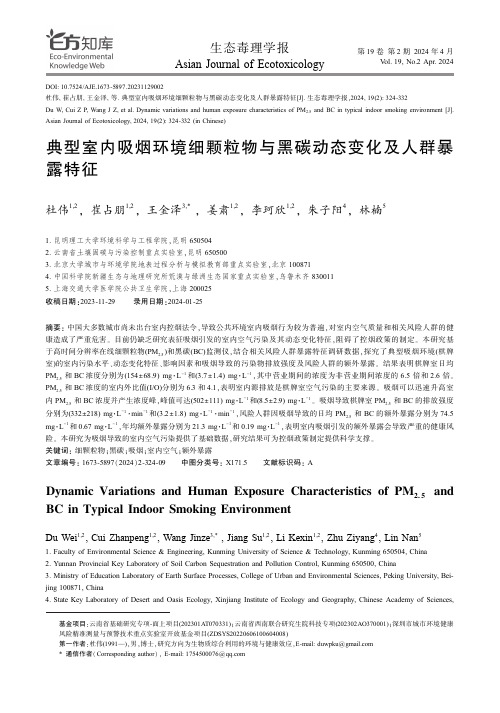
生态毒理学报Asian Journal of Ecotoxicology第19卷第2期2024年4月V ol.19,No.2Apr.2024㊀㊀基金项目:云南省基础研究专项-面上项目(202301AT070331);云南省西南联合研究生院科技专项(202302AO370001);深圳市城市环境健康风险精准测量与预警技术重点实验室开放基金项目(ZDSYS20220606100604008)㊀㊀第一作者:杜伟(1991 ),男,博士,研究方向为生物质综合利用的环境与健康效应,E -mail:****************㊀㊀*通信作者(Corresponding author ),E -mail:*****************DOI:10.7524/AJE.1673-5897.20231129002杜伟,崔占朋,王金泽,等.典型室内吸烟环境细颗粒物与黑碳动态变化及人群暴露特征[J].生态毒理学报,2024,19(2):324-332Du W,Cui Z P,Wang J Z,et al.Dynamic variations and human exposure characteristics of PM 2.5and BC in typical indoor smoking environment [J].Asian Journal of Ecotoxicology,2024,19(2):324-332(in Chinese)典型室内吸烟环境细颗粒物与黑碳动态变化及人群暴露特征杜伟1,2,崔占朋1,2,王金泽3,*,姜肃1,2,李珂欣1,2,朱子阳4,林楠51.昆明理工大学环境科学与工程学院,昆明6505042.云南省土壤固碳与污染控制重点实验室,昆明6505003.北京大学城市与环境学院地表过程分析与模拟教育部重点实验室,北京1008714.中国科学院新疆生态与地理研究所荒漠与绿洲生态国家重点实验室,乌鲁木齐8300115.上海交通大学医学院公共卫生学院,上海200025收稿日期:2023-11-29㊀㊀录用日期:2024-01-25摘要:中国大多数城市尚未出台室内控烟法令,导致公共环境室内吸烟行为较为普遍,对室内空气质量和相关风险人群的健康造成了严重危害㊂目前仍缺乏研究表征吸烟引发的室内空气污染及其动态变化特征,阻碍了控烟政策的制定㊂本研究基于高时间分辨率在线细颗粒物(PM 2.5)和黑碳(BC)监测仪,结合相关风险人群暴露特征调研数据,探究了典型吸烟环境(棋牌室)的室内污染水平㊁动态变化特征㊁影响因素和吸烟导致的污染物排放强度及风险人群的额外暴露㊂结果表明棋牌室日均PM 2.5和BC 浓度分别为(154ʃ68.9)mg ㊃L -1和(3.7ʃ1.4)mg ㊃L -1,其中营业期间的浓度为非营业期间浓度的6.5倍和2.6倍㊂PM 2.5和BC 浓度的室内外比值(I/O)分别为6.3和4.1,表明室内源排放是棋牌室空气污染的主要来源㊂吸烟可以迅速升高室内PM 2.5和BC 浓度并产生浓度峰,峰值可达(502ʃ111)mg ㊃L -1和(8.5ʃ2.9)mg ㊃L -1㊂吸烟导致棋牌室PM 2.5和BC 的排放强度分别为(332ʃ218)mg ㊃L -1㊃min -1和(3.2ʃ1.8)mg ㊃L -1㊃min -1,风险人群因吸烟导致的日均PM 2.5和BC 的额外暴露分别为74.5mg ㊃L -1和0.67mg ㊃L -1,年均额外暴露分别为21.3mg ㊃L -1和0.19mg ㊃L -1,表明室内吸烟引发的额外暴露会导致严重的健康风险㊂本研究为吸烟导致的室内空气污染提供了基础数据,研究结果可为控烟政策制定提供科学支撑㊂关键词:细颗粒物;黑碳;吸烟;室内空气;额外暴露文章编号:1673-5897(2024)2-324-09㊀㊀中图分类号:X171.5㊀㊀文献标识码:ADynamic Variations and Human Exposure Characteristics of PM 2.5and BC in Typical Indoor Smoking EnvironmentDu Wei 1,2,Cui Zhanpeng 1,2,Wang Jinze 3,*,Jiang Su 1,2,Li Kexin 1,2,Zhu Ziyang 4,Lin Nan 51.Faculty of Environmental Science &Engineering,Kunming University of Science &Technology,Kunming 650504,China2.Yunnan Provincial Key Laboratory of Soil Carbon Sequestration and Pollution Control,Kunming 650500,China3.Ministry of Education Laboratory of Earth Surface Processes,College of Urban and Environmental Sciences,Peking University,Bei -jing 100871,China4.State Key Laboratory of Desert and Oasis Ecology,Xinjiang Institute of Ecology and Geography,Chinese Academy of Sciences,第2期杜伟等:典型室内吸烟环境细颗粒物与黑碳动态变化及人群暴露特征325㊀Urumqi830011,China5.School of Public Health,Shanghai Jiao Tong University,Shanghai200025,ChinaReceived29November2023㊀㊀accepted25January2024Abstract:Exposure to smoke emitted by smoking can trigger serious health risks,while indoor smoking laws are still lacking for many Chinese cities,resulting in frequent smoking behavior in public indoor environments.Mean-while,limited studies have focused on indoor air pollution associated with smoking as well as its dynamic varia-tions.In this study,real-time high resolution sensors were used to explore pollution levels and dynamic variationsof indoor fine particles(PM2.5)and black carbon(BC)in typical smoking environments of mahjong and chess room.The contribution of smoking to indoor pollution and the extra pollutant exposure due to smoking were further calculated based on exposure characteristic data derived from questionnaire.Results showed that the dailyaverage concentrations of PM2.5and BC in mahjong and chess rooms were(154ʃ68.9)mg㊃L-1and(3.7ʃ1.4)mg㊃L-1,respectively.Higher PM2.5and BC concentrations were observed during operation period,which were6.5and2.6times of those during non-operation period.The indoor to outdoor ratios(I/O)of PM2.5and BC were6.3and 4.1,respectively,indicating the major contribution of indoor source to indoor air pollution.Smoking can rapidly in-crease indoor PM2.5and BC and generate concentration peaks,which can be as high as(502ʃ111)mg㊃L-1and(8.5ʃ2.9)mg㊃L-1,respectively.Indoor PM2.5and BC emission intensity attributed to smoking were(332ʃ218)mg㊃L-1㊃min-1and(3.2ʃ1.8)mg㊃L-1㊃min-1,respectively.The calculated daily averages of smoking-induced extra expo-sures of PM2.5and BC to target population were74.5mg㊃L-1and0.67mg㊃L-1,and were21.3mg㊃L-1and0.19 mg㊃L-1for annual averages,respectively,indicating severe health risks due to indoor smoking.This study fills in the data gap of indoor air pollution caused by smoking and can provide scientific support for formulating smoking control policies.Keywords:fine particles;black carbon;smoking;indoor air;extra exposure㊀㊀空气污染是影响人体健康的主要环境问题之一,全球每年有数百万人因空气污染暴露而过早死亡[1]㊂鉴于人们在室内所处时间的占比超过80%[2],因此相较于大气污染,室内空气污染对人体健康的危害更大,更应受到重视㊂室内排放源如吸烟形成的环境烟草烟雾可以显著地影响室内空气质量[3-5]㊂以往研究指出,环境烟草烟雾是室内颗粒物的重要排放源[6]㊂如Slezakova等[7]的研究显示,吸烟场所收集的室内细颗粒物(PM2.5)质量相较于禁烟场所增加了320%㊂类似地,Savdie等[8]研究指出吸烟会导致室内PM2.5及黑碳(BC)浓度显著升高,分别高于无吸烟时的背景值165倍和63倍㊂环境烟草烟雾中PM2.5的主要组分为有机碳㊁BC和K元素[9]㊂虽然BC的占比相对较低(如1.4%~1.9%)[9-10],但因其对人体健康的重要影响而引发关注[11-16]㊂有研究表明,BC对我国2000 2010年间PM2.5浓度增长的贡献仅为6.4%,但却是PM2.5归因死亡负担的主导组分(46.7%),表明其是PM2.5毒性的关键指标[9,17]㊂因此,BC的暴露特征需要引起人们的重视㊂吸烟不仅会直接影响主动吸烟人群的健康,还可以通过二手烟和三手烟暴露影响不吸烟人群的健康[18-19],因而广受关注㊂吸烟和二手烟暴露会引发心脑血管疾病㊁恶性肿瘤㊁呼吸系统疾病等在内的多种疾病[20-23]㊂据估算,全球每年因吸烟和二手烟暴露导致的死亡人数约为700万和120万[24]㊂针对吸烟尤其是室内吸烟对人体健康的危害,截至2020年,全球已有67个国家实施了 全面无烟法规 [25]㊂但目前中国仅有24个城市出台了控烟法规,且大多集中于发达城市,如北京和上海[26]㊂绝大部分地区,尤其是经济欠发达地区,尚未颁布控烟政策,导致这些地区室内吸烟行为相当普遍㊂而在诸如棋牌室和餐厅等娱乐消费场所,室内吸烟现象尤其严重,对暴露于其中的风险人群身体健康造成了严重危害㊂为阐明室内吸烟对居民健康的危害,对吸烟期间室内空气污染特征的研究至关重要㊂以往针对室内空气污染的研究大多基于滤膜采样,该方法可以对污染物成分谱进行详细分析[27-30]㊂但其时间分辨率较低,难以反映吸烟行为发生时室内空气污染的326㊀生态毒理学报第19卷动态变化特征㊂近年来,随着传感器技术的革新,高分辨率在线传感器被广泛应用于室内空气污染的评估,极大地推动了人们对室内空气污染的空间异质性㊁动态变化㊁垂直分布等特征的认知[31-34]㊂然而,目前利用在线仪器刻画典型室内吸烟环境污染特征的研究十分匮乏,导致吸烟环境污染水平等数据的缺失,阻碍了控烟政策的制定及推行㊂本研究选取棋牌室作为典型室内吸烟环境,利用高分辨率在线细颗粒物和黑碳监测仪持续监测棋牌室室内空气质量,旨在精确刻画吸烟行为对室内空气质量的影响,并结合相关风险人群的行为模式调查评估其额外暴露㊂本研究有望为吸烟行为对典型吸烟环境下室内空气质量的影响及相关健康风险的评估提供基础数据,并为我国控烟政策的制定提供科学依据㊂1㊀材料与方法(Materials and methods )1.1㊀采样点描述本研究开展于西南地区某市区,选取了具备营业资质的典型棋牌室开展研究,打麻将等娱乐方式在当地广为流行㊂棋牌室日常营业时间为13:00 19:00,偶尔可持续到21:00,上午一般不营业㊂棋牌室的每个房间都配备一张麻将桌,并装有独立的门窗和空调,营业期间棋牌室房门均关闭,由于在夏季采样,空调普遍打开㊂由于当地没有颁布室内控烟法令,故吸烟行为在当地棋牌室不受约束㊂1.2㊀数据获取本研究的采样时间为夏季(8月),累计2周㊂随机选取10个棋牌室房间进行采样,每个房间均放置一台PM 2.5监测仪和一台BC 监测仪㊂仪器放置要求为距墙1.0m ,离地1.5m ㊂PM 2.5监测仪为便携式颗粒物光学监测仪(攀藤PMS7003,泽帆公司,中国),采样分辨率为5s ,可同步监测环境温度和湿度㊂BC 监测仪为AE51在线BC 仪(microAeth ®AE51,AethLab ,美国),采样分辨率为1min ㊂同时使用标准问卷记录了棋牌室的房间参数信息(长㊁宽㊁高㊁开窗时间㊁开空调时间)㊁人员信息(性别㊁数量㊁所处时间)和吸烟行为(是否吸烟㊁吸烟数量)㊂此外,同步采集了室外PM 2.5和BC 数据以探究污染物的室内外关系,仪器放置于棋牌室旁边的一个三层建筑楼顶㊂1.3㊀质量控制和数据分析使用前,所有PM2.5监测仪均与标准仪器(实时在线环境颗粒物监测仪,model 5030,赛默飞科技,美国)进行了15d 以上的校准㊂校准结果显示,二者相关性超过0.990㊂BC 监测仪在监测前也经过校准,其误差小于5%,均满足研究需求㊂结合人群调研数据,利用公式(1)㊁(2)和(3)分别估算了风险人群因棋牌室吸烟暴露导致的日均和年均额外PM 2.5和BC 暴露浓度㊂C E =ðt 1(C indoor -C baseline )t(1)C E -daily =C E ˑt 1440(2)C E -annual =C Eˑt ˑ21440ˑ7(3)式中:C E 为因吸烟导致的污染物排放强度,mg ㊃L -1㊃min -1;C indoor 为室内污染物实时浓度,mg ㊃L -1;C baseline 为室内污染物背景浓度,即营业前30min 内的室内污染物浓度均值,mg ㊃L -1;t 为总营业时间,min ㊂根据本研究调研结果可知,棋牌室的平均营业时长t 为(315ʃ81.5)min ㊂C E -dail y 和C E -annual 分别表示因吸烟导致的污染物额外日均和年均暴露,mg ㊃L -1㊂1440为每天分钟数,7为每周天数㊂本研究假设每年额外暴露天数为每周2d ㊂此外,利用蒙特卡洛方法(运行10000次)模拟额外暴露计算中的不确定性,前提假设为污染物额外暴露呈对数正态分布,营业时间成正态分布,使用软件为Python(V 3.8.7)㊂2㊀结果与讨论(Results and discussion )2.1㊀浓度水平本研究共有76.9%的棋牌室被记录到室内吸烟行为,其中,平均吸烟数量为(35.1ʃ26.6)支,表明棋牌室吸烟现象普遍㊂棋牌室日均PM 2.5浓度为(154ʃ68.9)mg ㊃L -1,范围为56.6~261mg ㊃L -1,日均BC浓度为(3.7ʃ1.4)mg ㊃L -1,范围为1.9~6.3mg ㊃L -1㊂我国‘室内空气质量标准“(GB/T 18883 2022)规定的室内PM 2.5日均标准为50mg ㊃L -1[35]㊂与该标准相比,棋牌室PM 2.5的超标率为100%,且高于该标准1.1倍~5.2倍,表明棋牌室严重的PM 2.5污染㊂为研究吸烟对室内空气质量的影响,本研究进一步将测定时间划分为营业期间(即房间内有人打麻将)和非营业期间(即房间无人)㊂如图1所示,营业期间室内PM 2.5和BC 的浓度分别为(382ʃ220)mg ㊃L -1和(4.9ʃ2.2)mg ㊃L -1,而非营业期间的浓度则分别为(58.7ʃ13.2)mg ㊃L -1和(1.9ʃ0.6)mg ㊃L -1,分别低第2期杜伟等:典型室内吸烟环境细颗粒物与黑碳动态变化及人群暴露特征327㊀于营业期间6.5倍和2.6倍,表明营业期间室内更严重的空气污染㊂鉴于非营业期间棋牌室没有明显人为排放源,因此营业期间的污染源(室内吸烟)是棋牌室空气污染的主要贡献源㊂以往研究也报道了吸烟对不同场所室内PM2.5和BC浓度的重要贡献㊂例如陈陵等[36]报道南昌市5类公共场所(学校㊁办公室㊁卫生所㊁交通场所及餐厅)的室内PM2.5浓度为63.46~164.64mg㊃L-1,其中禁烟场所内的PM2.5浓度(72.48ʃ36.10)mg㊃L-1显著低于不禁烟场所(153.95ʃ122.69)mg㊃L-1㊂李善鹏等[37]测定了青岛市5类公共场所(餐厅㊁宾馆㊁学校㊁医院和政府机构)的室内PM2.5浓度,发现相较于学校和医院这类重点控烟场所(室内PM2.5浓度分别为51.2mg㊃L-1和69.4mg㊃L-1),餐厅和宾馆因控烟较难,室内PM2.5污染更严重(浓度分别为97.3mg㊃L-1和77.6mg㊃L-1)㊂Lu等[38]基于高分辨率在线仪器量化了不同人类活动对北京市城区住宅内PM2.5的贡献,发现吸烟的贡献为每支香烟(0.34ʃ0.24)mg㊃L-1㊂目前鲜有研究表征吸烟对室内环境中BC浓度的影响,仅有的研究表明吸烟同样可以加剧室内BC污染㊂如Lin等[39]研究发现,吸烟可以显著升高汽车内BC浓度,其中,有吸烟和无吸烟情景下车内的BC浓度分别为9.0mg㊃L-1和2.1mg㊃L-1㊂综上,吸烟对室内空气质量有较大影响,因此有必要在中国进一步推进室内控烟政策,从而改善室内空气质量㊂2.2㊀动态变化特征图2展示了室内和室外PM2.5和BC浓度的典型日变化特征㊂如图2所示,非营业期间,室内PM2.5和BC的浓度变化较为平稳,均维持在相对较低的水平㊂营业期间,室内PM2.5和BC浓度迅速升高,从人员进入后8min出现第一个浓度峰,此后一直维持在较高浓度㊂在此期间,PM2.5浓度均值为(397ʃ130)mg㊃L-1,最高可达713mg㊃L-1,显著高于非营业期间的(46.2ʃ23.3)mg㊃L-1㊂营业期间共观察到14个PM2.5浓度峰,单个峰的持续时间为11~ 36min,平均持续时间为(22.5ʃ7.8)min㊂峰值为301 ~713mg㊃L-1,平均峰值为(502ʃ111)mg㊃L-1㊂营业期间棋牌室的人为PM2.5排放源为吸烟,因此PM2.5的浓度峰是由吸烟导致的㊂而营业期间棋牌室BC平均浓度为(6.4ʃ3.0)mg㊃L-1,是非营业期间BC浓度的1.8倍,为(3.5ʃ1.9)mg㊃L-1,BC浓度峰值为5.0~13.8mg㊃L-1,平均峰值为(8.5ʃ2.9)mg㊃L-1㊂营业期间室内BC的动态变化特征与PM2.5相似,且二者浓度峰出现时间一致,这可归因于二者一致的排放源㊂Zhou等[40]基于短期采样(1~2h)研究了纽约市酒吧因吸烟引发的室内空气污染,结果显示吸烟会显著加剧酒吧内PM2.5和BC污染(小时均值浓度分别为1180mg㊃L-1和4.1mg㊃L-1)㊂此外,该研究也观察到酒吧内PM2.5与BC相似的动态变化特征,与本研究结果一致㊂营业结束后,工作人员会将房门打开通风,导致室内PM2.5浓度会在30min内图1㊀棋牌室内PM2.5和黑碳(BC)的日均浓度Fig.1㊀The daily average concentrations of PM2.5and black carbon(BC)in mahjong and chess room328㊀生态毒理学报第19卷图2㊀典型室内外PM2.5及BC浓度的日变化特征Fig.2㊀Typical diurnal variations of indoor and outdoor PM2.5and BC in mahjong and chess room迅速下降到房间背景浓度㊂在此阶段,还观察到一个PM2.5和BC的浓度峰,峰值分别为206mg㊃L-1和6.2mg㊃L-1,可能是由于室内尚未熄灭的烟头持续燃烧排放PM2.5和BC导致的㊂室外PM2.5与BC的日变化特征较为相似,呈现早晚高,下午低的变化趋势㊂早晚较高的PM2.5与BC浓度主要是由于早高峰和晚高峰时段机动车尾气排放增多导致的[41]㊂此外,夜间大气边界层高度较低,扩散条件差,污染物容易积聚从而导致夜间污染物浓度升高㊂而下午机动车排放减少,且大气边界层的抬升有利于污染物扩散从而导致PM2.5及BC浓度的降低㊂类似的大气PM2.5和BC的日变化特征在我国多个城市均有报道[41-43]㊂2.3㊀室内外污染物关系污染物室内浓度与室外浓度的比值(I/O)可以反映室内源和室外源对室内环境的影响㊂基于高时间分辨率数据,本研究计算了PM2.5与BC浓度的室内外比值㊂如图3所示,棋牌室PM2.5和BC的I/O均值分别为6.3和4.1,均大于1.0,表明室内源对室内空气质量的影响大于室外源㊂此外,PM2.5和BC的I/O中位数分别为1.6和1.9,小于平均值,表明二者I/O的分布相较于正态分布偏右(偏度分别为3.0和21.7)㊂棋牌室I/O的右拖尾源自于吸烟导致室内PM2.5和BC浓度升高,而二者的室外浓度相对稳定,从而导致室内外浓度比值出现极高值㊂营业期间PM2.5和BC的I/O比值分别为18.0(中位数:13.3)和4.7(中位数:2.6),显著高于非营业期间的2.8(中位数:1.3)和3.1(中位数:1.1)㊂Men等[44]研究了河北农村燃煤家庭PM2.5的I/O变化特征,结果表明这些家庭PM2.5的I/O均值为1.95,中位数为1.24,呈右偏分布㊂此外,该研究还指出在室内源排放更强烈的供暖期,PM2.5的I/O比值相较于非供暖期间更高(分别为2.08和1.65),与本研究结果一致,再次表明室内源排放对室内空气污染的重要贡献㊂2.4㊀影响因素基于相关性分析研究了棋牌室PM2.5和BC浓度的影响因素㊂如图4(a)所示,棋牌室PM2.5与BC浓度与营业期间PM2.5与BC浓度显著正相关,而与非营业期间和室外的PM2.5与BC浓度的相关性较弱,表明室内源排放对棋牌室空气质量的影响更大㊂第2期杜伟等:典型室内吸烟环境细颗粒物与黑碳动态变化及人群暴露特征329㊀图3㊀PM 2.5与BC 浓度的室内外(I /O )比值Fig.3㊀Indoor and outdoor (I/O)relationships of PM 2.5ad BC鉴于此,本文进一步研究了营业期间棋牌室PM 2.5和BC 浓度的影响因素㊂如图4(b)所示,营业期间棋牌室PM 2.5与BC 浓度与房间内烟头数量显著正相关,表明室内抽烟数量越多,空气污染则越严重㊂因此,有必要减少棋牌室的吸烟行为㊂此外,营业期间棋牌室PM 2.5与BC 浓度也与营业时长呈显著正相关关系,这主要可以归因于以下2点:首先棋牌室营业时,室内为半封闭状态,较长的营业时间有利于污染物的积累;其次,营业时长与烟头数量显著正相关(图4(b)),表明长时间打麻将往往会伴随更多的吸烟活动,从而加剧室内空气污染㊂而营业期间室内PM 2.5与BC 浓度与通风条件并无显著相关关系,这可能是由于大部分棋牌室的窗户(53.8%)于营业期间一直开启,导致不同房间通风条件的差异较小所导致的㊂2.5㊀吸烟排放强度及风险人群额外暴露浓度基于公式(1),本文计算了因室内吸烟导致的PM 2.5及BC 的排放强度㊂结果显示,棋牌室营业期间PM 2.5的排放强度为(332ʃ218)mg ㊃L -1㊃min -1,范围为41.2~745mg ㊃L -1㊃min -1㊂BC 的排放强度则为(3.2ʃ1.8)mg ㊃L -1㊃min -1,范围为0.8~6.9mg ㊃L -1㊃min -1㊂此外,PM 2.5和BC 额外排放强度与吸烟数量显著正相关(P <0.01),平均每支烟对营业期间PM 2.5和BC 排放强度的贡献分别为6.2mg ㊃L -1㊃min -1和0.06mg ㊃L -1㊃min -1㊂基于吸烟排放强度数据和调研得到相关风险人群暴露数据,本研究利用公式(2)和公式(3)估算了风险人群暴露于棋牌室PM 2.5和BC 的额外暴露浓度㊂如图5所示,风险人群日均和年均PM 2.5额外暴露浓度分别为74.5(中位数:50.4)mg㊃L -1和21.3(中位数:14.4)mg ㊃L -1,日均和年均BC 额外暴露浓度则分别为0.67(中位数:0.54)mg ㊃L -1和0.19(中位数:0.15)mg ㊃L -1㊂以世界卫生组织(WHO)建议的PM 2.5标准为基准(日均:15mg ㊃L -1,年均:5mg ㊃L -1),风险人群日均及年均PM 2.5额外暴露浓度严重超标,分别高于WHO 建议的标准5.0倍及4.3倍,表明风险人群会因吸烟暴露而导致的较高的健康风险㊂2.6㊀小结与展望吸烟可对人体健康造成严重危害,不吸烟人群对室内吸烟行为普遍有较强的排斥心理㊂然而由于立法的滞后性,中国大部分地区尚未出台室内控烟法令㊂目前,中国无烟立法保护人口仅有2.24亿人,健康中国控烟行动仅完成15.9%,距离2030年的目标(80%)仍相去甚远㊂而在出台室内禁烟令的地区,由于监管缺失,室内吸烟在一些娱乐场所仍较为普遍,因吸烟引发的室内空气污染和人体健康威胁的事情屡见不鲜㊂然而,由于污染数据的缺失,极大地阻碍了导致对室内吸烟的污染水平及健康风险的评估,不利于室内控烟法令的推行㊂本研究基于高分辨率PM 2.5和BC 在线传感器研究了典型吸烟环境室内的污染特征及人群暴露风险,结果表明吸烟会显著降低室内空气质量,并对暴露在此情景中的风险人群造成严重的健康威胁㊂因此,有必要推动室内控烟法令的实施,并进一步加强330㊀生态毒理学报第19卷图4㊀室内污染物浓度与潜在影响因素的相关性分析注:前缀OP ㊁NOP 和OD 分别表示营业期间㊁非营业期间和室外污染物浓度;RH ㊁T ㊁Butt ㊁Time 和Ventilation 分别表示相对湿度㊁温度㊁烟头数量㊁营业时长和通风条件㊂Fig.4㊀Correlation analysis of indoor air pollutant concentrations and potential influencing factorsNote:The prefixes OP,NOP,and OD indicate the concentration of pollutants during operation period,non -operation period,and outdoor,respectively;RH,T,butt,time,and ventilation indicate relative humidity,temperature,number of cigarette butts,operation hours,and ventilation condition,respectively.图5㊀风险人群PM 2.5及BC 额外暴露的累积分布函数Fig.5㊀Cumulative distribution of PM 2.5and BC additional exposure for target populations对室内吸烟的管控,如加大处罚力度㊂鉴于室内不同微环境间污染水平的差异性和区域及人群间暴露特征的复杂性,期待未来更多的研究从大范围㊁长时间㊁多因素的角度出发,探究吸烟导致的室内空气污染特征及其引发的健康风险,从而为控烟政策推行提供数据支撑,为保护人群健康,助力生态文明建设提供科学依据㊂通信作者简介:王金泽(1997 ),男,博士研究生,主要研究方向为室内外空气污染与人体健康㊂第2期杜伟等:典型室内吸烟环境细颗粒物与黑碳动态变化及人群暴露特征331㊀参考文献(References):[1]㊀IQAir.Interactive global map of2022PM2.5concentra-tions by city[EB/OL].(2022-03-22)[2023-11-10].https:///us/world-air-quality-report[2]㊀Li Y G,Wang Y Q,Wang J Z,et al.Quantify individualvariation of real-time PM2.5exposure in urban Chinese homes based on a novel method[J].Indoor Air,2022,32(1):e12962[3]㊀Du W,Li X Y,Chen Y C,et al.Household air pollutionand personal exposure to air pollutants in rural China:Areview[J].Environmental Pollution,2018,237:625-638[4]㊀Huang Y,Wang J Z,Chen Y,et al.Household PM2.5pol-lution in rural Chinese homes:Levels,dynamic character-istics and seasonal variations[J].The Science of the TotalEnvironment,2022,817:153085[5]㊀Qin L F,Zhai M K,Cheng H F.Indoor air pollution fromthe household combustion of coal:Tempo-spatial distribu-tion of gaseous pollutants and semi-quantification ofsource contribution[J].The Science of the Total Environ-ment,2023,882:163502[6]㊀Gauvin S,Reungoat P,Cassadou S,et al.Contribution ofindoor and outdoor environments to PM2.5personal expo-sure of children:VESTA study[J].The Science of the To-tal Environment,2002,297(1-3):175-181[7]㊀Slezakova K,Pires J C M,Martins F G,et al.Identifica-tion of tobacco smoke components in indoor breathableparticles by SEM-EDS[J].Atmospheric Environment,2011,45(4):863-872[8]㊀Savdie J,Canha N,Buitrago N,et al.Passive exposure topollutants from a new generation of cigarettes in real lifescenarios[J].International Journal of Environmental Re-search and Public Health,2020,17(10):3455[9]㊀Zhang N,Han B,Zhao R J,et al.Source profile and ex-cess cancer risk evaluation of environmental tobaccosmoking under real conditions,China[J].AtmosphericPollution Research,2019,10(6):1994-1999[10]㊀梅敏花.环境烟草烟雾中颗粒物上载带组分及净化研究[D].金华:浙江师范大学,2015:16-20Mei M H.Carrying components analysis and purificationefficient of particulate matter in environmental tobaccosmoke[D].Jinhua:Zhejiang Normal University,2015:16-20(in Chinese)[11]㊀Harbo Poulsen A,Arthur Hvidtfeldt U,Sørensen M,et al.Components of particulate matter air-pollution and braintumors[J].Environment International,2020,144:106046 [12]㊀Rabito F A,Yang Q,Zhang H,et al.The association be-tween short-term residential black carbon concentration onblood pressure in a general population sample[J].IndoorAir,2020,30(4):767-775[13]㊀Xu Y F,Chen X,Han Y Q,et al.Ceramide metabolismmediates the impaired glucose homeostasis followingshort-term black carbon exposure:A targeted lipidomic a-nalysis[J].The Science of the Total Environment,2022,829:154657[14]㊀Chen X,Han Y Q,Chen W,et al.Respiratory inflamma-tion and short-term ambient air pollution exposures in a-dult Beijing residents with and without prediabetes:Apanel study[J].Environmental Health Perspectives,2020,128(6):67004[15]㊀De Prins S,Dons E,van Poppel M,et al.Airway oxida-tive stress and inflammation markers in exhaled breathfrom children are linked with exposure to black carbon[J].Environment International,2014,73:440-446 [16]㊀Shang Y,Liu M Y,Wang T T,et al.Modifications of au-tophagy influenced the Alzheimer-like changes in SH-SY5Y cells promoted by ultrafine black carbon[J].Envi-ronmental Pollution(Barking,Essex:1987),2019,246:763-771[17]㊀Xue T,Zheng Y X,Li X,et al.A component-specific ex-posure-mortality model for ambient PM2.5in China:Find-ings from nationwide epidemiology based on outputsfrom a chemical transport model[J].Faraday Discussions,2021,226:551-568[18]㊀Krist A H,Davidson K W,Mangione C M,et al.Inter-ventions for tobacco smoking cessation in adults,inclu-ding pregnant persons:US preventive services task forcerecommendation statement[J].Journal of the AmericanMedical Association,2021,325(3):265-279[19]㊀Tabatabaei Z,Hoseini M,Fararooei M,et al.Biomonitor-ing of BTEX in primary school children exposed to hook-ah smoke[J].Environmental Science and Pollution Re-search International,2022,29(45):69008-69021[20]㊀Benowitz N L,Burbank A D.Cardiovascular toxicity ofnicotine:Implications for electronic cigarette use[J].Trends in Cardiovascular Medicine,2016,26(6):515-523 [21]㊀Jacobs D R Jr,Woo J G,Sinaiko A R,et al.Childhoodcardiovascular risk factors and adult cardiovascular events[J].The New England Journal of Medicine,2022,386(20):1877-1888[22]㊀Gotts J E,Jordt S E,McConnell R,et al.What are the re-spiratory effects of e-cigarettes?[J].BMJ,2019,366:l5275[23]㊀王辰,肖丹,池慧.‘中国吸烟危害健康报告2020“概要[J].中国循环杂志,2021,36(10):937-952Wang C,Xiao D,Chi H.2020report on health hazards ofsmoking in China:An updated summary[J].Chinese Cir-332㊀生态毒理学报第19卷culation Journal,2021,36(10):937-952(in Chinese) [24]㊀World Health Origination.Tobacco[EB/OL].(2023-07-13)[2023-11-10].https://www.who.int/news-room/fact-sheets/detail/tobacco[25]㊀World Health Origination.WHO report on the global to-bacco epidemic2021:Addressing new and emergingproducts[EB/OL].(2021-07-27)[2023-11-10].https://www.who.int/china/publications-detail/9789240032095 [26]㊀王轩,薛悟娟.中国控烟法治发展报告(2021)[J].民主与法制,2022(13):48-53[27]㊀He K L,Xu H M,Feng R,et al.Characteristics of indoorand personal exposure to particulate organic compoundsemitted from domestic solid fuel combustion in rural areasof Northwest China[J].Atmospheric Research,2021,248:105181[28]㊀Zhang B,Sun J,Jiang N,et al.Emission factors,charac-teristics,and gas-particle partitioning of polycyclic aro-matic hydrocarbons in PM2.5emitted for the typical solid fuel combustions in rural Guanzhong Plain,China[J].En-vironmental Pollution,2021,286:117573[29]㊀Wang J Z,Zhang S S,Chen Y,et al.Field based measure-ment of multiple pollutant emissions from residential coalburning in rural Shanxi,Northern China[J].AtmosphericPollution Research,2021,12(2):443-450[30]㊀Wang D B,Li Q,Shen G F,et al.Significant ultrafineparticle emissions from residential solid fuel combustion[J].The Science of the Total Environment,2020,715:136992[31]㊀Ainiwaer S,Chen Y L,Shen G F,et al.Characterizationof the vertical variation in indoor PM2.5in an urban apart-ment in China[J].Environmental Pollution,2022,308:119652[32]㊀Li X Y,Baumgartner J,Harper S,et al.Field measure-ments of indoor and community air quality in rural Bei-jing before,during,and after the COVID-19lockdown[J].Indoor Air,2022,32(8):e13095[33]㊀Wang J Z,Du W,Lei Y L,et al.Quantifying the dynamiccharacteristics of indoor air pollution using real-time sen-sors:Current status and future implication[J].Environ-ment International,2023,175:107934[34]㊀Reis J,Lopes D,Graça D,et ing low-cost sensors toassess real-time comfort and air quality patterns in indoorhouseholds[J].Environmental Science and Pollution Re-search International,2023,30(3):7736-7751[35]㊀国家市场监督管理总局,国家标准化管理委员会.室内空气质量标准:GB/T18883 2022[S].北京:中国标准出版社,2022[36]㊀陈陵,范义兵,杨树,等.南昌市公共场所室内空气PM2.5浓度调查[J].卫生研究,2014,43(1):146-148Chen L,Fan Y B,Yang S,et al.Investigation on indoorair PM2.5concentration in public places in Nanchang[J].Journal of Hygiene Research,2014,43(1):146-148(inChinese)[37]㊀李善鹏,刘辉,綦斐.青岛市2012年室内场所烟草烟雾PM2.5检测分析[J].中国公共卫生,2016,32(5):577-579Li S P,Liu H,Qi F.Indoor PM2.5concentration in public places in Qingdao City,2012[J].Chinese Journal of Pub-lic Health,2016,32(5):577-579(in Chinese)[38]㊀Lu C X,Xu H R,Meng W J,et al.A novel model for re-gional indoor PM2.5quantification with both external and internal contributions included[J].Environment Interna-tional,2020,145:106124[39]㊀Lin N,Du W,Wang J Z,et al.The effect of COVID-19restrictions on particulate matter on different modes oftransport in China[J].Environmental Research,2022,207:112205[40]㊀Zhou S,Weitzman M,Vilcassim R,et al.Air quality inNew York City hookah bars[J].Tobacco Control,2015,24(e3):e193-e198[41]㊀张灿,周志恩,翟崇治,等.重庆市黑碳气溶胶特征及影响因素初探[J].环境科学学报,2014,34(4):812-818Zhang C,Zhou Z E,Zhai C Z,et al.Characteristics andinfluencing factors of black carbon aerosol in Chongqing[J].Acta Scientiae Circumstantiae,2014,34(4):812-818(in Chinese)[42]㊀曹阳,安欣欣,刘保献,等.北京市黑碳气溶胶浓度特征及其主要影响因素[J].环境科学,2021,42(12):5633-5643Cao Y,An X X,Liu B X,et al.Characteristics and maininfluencing factors of black carbon aerosol in Beijing[J].Environmental Science,2021,42(12):5633-5643(in Chi-nese)[43]㊀汤莉莉,祝愿,牛生杰,等.南京北郊大气细粒子中黑碳气溶胶的观测研究[J].环境科学学报,2011,31(4):709-716Tang L L,Zhu Y,Niu S J,et al.Observation of black car-bon in fine particulate matter in the north suburb of Nan-jing[J].Acta Scientiae Circumstantiae,2011,31(4):709-716(in Chinese)[44]㊀Men Y T,Li J P,Liu X L,et al.Contributions of internalemissions to peaks and incremental indoor PM2.5in rural coal use households[J].Environmental Pollution,2021,288:117753Ң。
室内空气污染案例
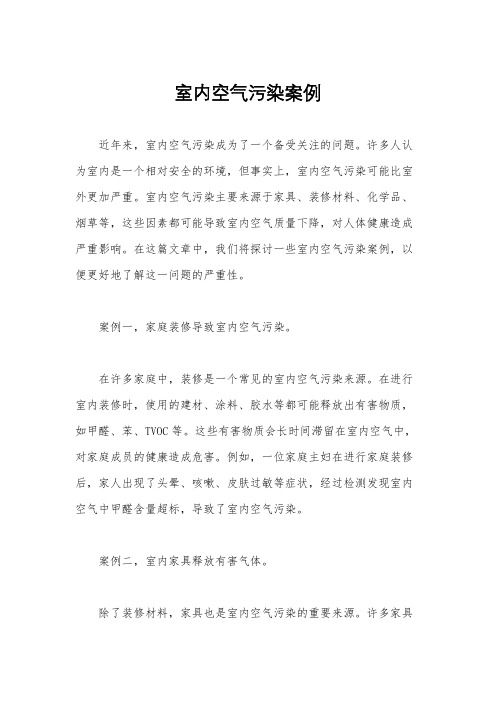
室内空气污染案例近年来,室内空气污染成为了一个备受关注的问题。
许多人认为室内是一个相对安全的环境,但事实上,室内空气污染可能比室外更加严重。
室内空气污染主要来源于家具、装修材料、化学品、烟草等,这些因素都可能导致室内空气质量下降,对人体健康造成严重影响。
在这篇文章中,我们将探讨一些室内空气污染案例,以便更好地了解这一问题的严重性。
案例一,家庭装修导致室内空气污染。
在许多家庭中,装修是一个常见的室内空气污染来源。
在进行室内装修时,使用的建材、涂料、胶水等都可能释放出有害物质,如甲醛、苯、TVOC等。
这些有害物质会长时间滞留在室内空气中,对家庭成员的健康造成危害。
例如,一位家庭主妇在进行家庭装修后,家人出现了头晕、咳嗽、皮肤过敏等症状,经过检测发现室内空气中甲醛含量超标,导致了室内空气污染。
案例二,室内家具释放有害气体。
除了装修材料,家具也是室内空气污染的重要来源。
许多家具中使用的胶水、涂料等含有挥发性有机化合物(VOCs),长时间使用后会释放出有害气体。
一位办公室职员在购买新的办公家具后,出现了头晕、恶心、咳嗽等症状,经过检测发现家具释放的VOCs超标,导致了办公室室内空气污染。
案例三,烟草烟雾引发室内空气污染。
烟草烟雾是室内空气污染的重要来源之一。
长期吸烟会导致室内空气中烟雾浓度升高,对家庭成员的健康造成严重危害。
一位家庭主妇在家人长期吸烟后,出现了呼吸困难、咳嗽、眼睛不适等症状,经过检测发现室内空气中烟雾浓度超标,导致了室内空气污染。
案例四,化学品使用引发室内空气污染。
在日常生活中,许多家庭使用化学品进行清洁、消毒等,然而这些化学品中含有挥发性有机化合物,使用过程中会释放出有害气体,导致室内空气污染。
一位家庭主妇在使用清洁剂后,出现了头晕、恶心、咳嗽等症状,经过检测发现室内空气中有害气体浓度超标,导致了室内空气污染。
以上案例表明,室内空气污染是一个严重的问题,对人体健康造成了严重影响。
为了改善室内空气质量,我们可以采取一些措施,如选择低挥发性有机化合物含量的建材、家具,加强室内通风,使用空气净化器等。
吸烟和装修产生的污染物对人体健康影响

如何减少吸烟和装修产生
03 的污染物对人体健康的影 响
戒烟的方法和技巧
01
02
03
04
认知行为疗法
通过改变吸烟者的错误认知, 提高戒烟意愿,增强戒烟决心
。
尼古丁替代疗法
使用尼古丁贴片、口香糖、喷 雾剂等替代品,逐渐减少对尼
古丁的依赖。
药物治疗
在医生的指导下,使用戒烟药 物如盐酸安非他酮等,帮助缓 解戒烟过程中的不适症状。
推广环保材料
鼓励和推广使用环保、无害的装修材料,减少装修过程中产生的 污染物。
推广健康的生活方式
倡导健康饮食
提倡均衡饮食,增加蔬菜水果摄入,减少油腻、高热量食物,有 助于提高身体免疫力。
增加体育锻炼
鼓励人们积极参加体育锻炼,增强身体素质,提高抵抗力。
保持良好的生活习惯
保证充足的睡眠,避免熬夜和过度疲劳,有助于保持身体健康。
甲醛对人体的危害主要表现在刺激眼睛、鼻子和 喉咙,引起头痛、头晕、恶心等症状。
长期接触甲醛会增加患上鼻咽癌和白血病的风险, 尤其是对儿童和孕妇的危害更为显著。
苯对人体健康的影响
苯是一种常见的装修污染物,主要来源于油漆、家具制造过程中使用的添加剂等。
苯对人体的危害主要表现在影响中枢神经系统,导致头痛、恶心、呕吐等症状,严 重时甚至可能导致昏迷和死亡。
寻求支持
与家人、朋友或戒烟支持小组 分享戒烟计划,寻求他们的鼓 励和支持,增强戒烟动力。
选择环保装修材料
无毒无害
选择无毒或低毒性的装修材料,如水 性涂料、无醛板材等,尽量避免使用 含甲醛等有害物质的材料。
绿色建材
优先选择通过环保认证的绿色建材, 如绿色建筑板、环保漆等,降低室内 污染物浓度。
抽烟的人对室内的人的影响的作文

抽烟的人对室内的人的影响的作文
标题:抽烟的人对室内的人的影响
吸烟不仅危害自身健康,同时也给室内的其他人带来了严重的二手烟危害。
二手烟中含有大量有毒有害物质,如尼古丁、一氧化碳、苯并芘等,这些物质会导致呼吸系统疾病、心血管疾病、癌症等严重疾病。
室内吸烟会使空气质量极为恶劣,烟雾会污染空气,令人难以呼吸。
此外,烟雾中的有害物质会附着在墙壁、地板、家具等物体表面,即使吸烟者离开后,这些残留物仍会持续释放有毒气体,影响室内其他人的健康。
孕妇、婴儿和儿童更容易受到二手烟的伤害。
二手烟会增加婴儿患肺炎、支气管炎等呼吸系统疾病的风险。
儿童接触二手烟,可能会影响肺部发育,导致肺活量减小。
为了保护室内其他人的健康,抽烟者应当远离室内区域吸烟。
在公共场所、工作场所等禁止吸烟区域绝对不可吸烟。
保护他人远离二手烟危害是每个人应尽的义务。
让我们共同维护良好的室内空气质量,共创健康舒适的生活环境。
吸烟室内空气质量净化处理方案

吸烟室空气质量净化处理—吸烟净化机方案安徽宾肯电气有限公司张文局摘要大气污染日益严重,公众对PM2.5越来越关注,“吸烟有害健康”已经不再是一个单纯的宣传标语。
二手烟,更是健康的杀手,殃及了多少无辜的人。
随着公众环保意识的加强、健康意识的提升,庞大的烟民群体,逐渐的走进了厕所、走进了吸烟室。
可是你知道吗,吸烟室里,空气的污染有多严重,你想都不敢想象。
一个简单的数字告诉你:500-1000!超过正常值的20-30倍!您一面在惬意的吞云吐雾,一面在呼吸着别人的二手烟。
可是您的健康呢?本文讲述的就是如何对吸烟室空气质量进行净化处理,还公众一个安全的呼吸空间。
关键词PM2.5 空气净化呼吸安全Air Quality Purification Scheme of Smoking RoomAbstract Air pollution is increasingly serious, the public concernes about the PM2.5 more and more, "smoking is harmful to health" is no longera simple slogans. Secondhand smoke is a also healthkiller, many peopleare innocented. Along with the strengthening of public awareness of environmental protection, health consciousness, huge smokers, gradually into the toilet, went into the smoking room. But you know, smoking room, air pollution is more serious, you will can not imagine. A simple digital tellyou: 500-1000! 20-30 times more than the normal value! Your side in the cozy to smoke opium, whilebreathing second-hand smoke of others. But,do you carefor your health? This paper will tell about how to purify the air quality in the smoking room,giving the public a safe space to breathe.Key words PM2.5 air purification the safety of breathing 引言吸烟室内一般设施简陋,通风条件差,PM2.5远远超出标准值,对人体健康危害极大。
烟草烟雾对室内空气颗粒物浓度的影响

第一作者:吴伟伟,男,1983年生,硕士研究生,研究方向为现代电子技术在环境中的应用。
#通讯作者。
3中国科学院知识创新工程重要方向项目(No.K J CX 23SYW 2N3);中国科学院上海应用物理研究所领域前沿项目(No.90070301);国家自然科学基金资助项目(No.10775174)。
烟草烟雾对室内空气颗粒物浓度的影响3吴伟伟1,2 许忠杨1,3 赵桂芝3 林 俊1 刘 卫1# 李 燕1(1.中国科学院上海应用物理研究所,上海201800;2.重庆邮电大学光电工程学院,重庆400065;3.南华大学核科学技术学院,湖南 衡阳421001) 摘要 采用电称冲击低压系统(EL PI )将无烟室和吸烟室内的空气颗粒物(0.03~10.00μm )分成12级,对其粒子数和质量浓度进行测定。
结果表明,吸烟室PM 0.03~10.00的日平均粒子数和质量浓度分别是无烟室的1.50、1.13倍。
烟草烟雾对室内颗粒物粒子数的影响集中在0.03~1.00μm 粒径段;对室内颗粒物质量浓度的影响表现为双模态结构,峰值分别在0.20~0.70、5.00~8.20μm 粒径段。
烟草烟雾颗粒物的粒子数和质量浓度随烟雾消散时间的增加而减少,粒径越小,减小的越明显;烟草烟雾颗粒物在室内消散缓慢,会在长时间内造成影响,应引起足够关注。
关键词 烟草烟雾 颗粒物 粒径分布 电称冲击低压系统E ffects of tob acco smoke on indoor airborne p articles W u Weiwei 1,2,X u Zhong y ang 1,3,Zhao Guiz hi 3,L in J un 1,L i u Wei 1,L i Yan 1.(1.S hanghai I nstitute of A p plied Physics ,Chinese A cadem y of Sciences ,S hanghai 201800;2.Col 2lege of Elect ronic Engineering ,Chongqing Universit y of Post and Telecomm unications ,Chongqing 400065;3.S chool of N uclear S cience and Technolog y ,Universit y of S outh China ,Hengy ang H unan 421001)Abstract : Understanding the effects of tobacco smoke on indoor environment is essential for improving the in 2door environment and protecting human health.An electrical low pressure impactor (EL PI )was employed to determine concentrations of number and mass of 12size classes (mean particle diameter ranged f rom 0.03to 10.00μm )of air 2borne particulate matters in smoking and non 2smoking rooms.The concentrations of number and mass of airborne particles in smoking room were 1.76times and 1.29times ,respectively ,of those found in the non 2smoking room.The mass concentration of particulates emitted from tobacco smoke in indoor air exhibited the bimodal distribution patterns showing peaks for the 0.2020.70μm and 5.0028.20μm size f ractions.Particulates emitted f rom tobacco smoke affected primarily on the number concentrations of those with size of 0.0321.00μm.The particle size affected both the diff usion rates and number &mass concentrations of the particulate matters ;smaller particulates diff used more quickly.The tobacco smoke particles dissipated slowly indoor.The health effect of their long staying time in the indoor environment is a matter of concern.K eyw ords : tobacco smoke ;particulate matters ;size distribution ;EL PI 现代人的大部分时间都是在室内环境中度过[1],室内空气质量日益受到人们的关注。
室内吸烟后烟气污染的数值模拟研究
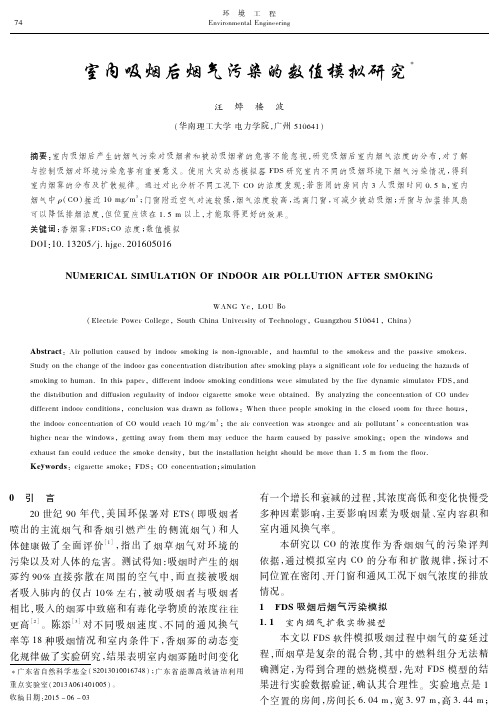
室内吸烟后烟气污染的数值模拟研究!汪$烨$楼$波!华南理工大学电力学院"广州,"’(&"$摘要!室内吸烟后产生的烟气污染对吸烟者和被动吸烟者的危害不能忽视!研究吸烟后室内烟气浓度的分布!对了解与控制吸烟对环境污染危害有重要意义"使用火灾动态模拟器]<L 研究室内不同的吸烟环境下烟气污染情况!得到室内烟雾的分布及扩散规律"通过对比分析不同工况下E=的浓度发现$若密闭的房间内;人吸烟时间’%,A !室内烟气中!&E =’接近"’/01/;%门窗附近空气对流较强!烟气浓度较高!远离门窗!可减少被动吸烟%开窗与加装排风扇可以降低排烟浓度!但位置应该在"%,/以上!才能取得更好的效果"关键词!香烟雾%]<L %E =浓度%数值模拟<=>%"’%";#’,1?@A?0:@#’"(’,’"()3,"%’0$+!’,3+$&’()(*’)2((%$’%#(++3&’()$*&"%!,(<’)W-B C Da P "2=V_M!Q N P :U R 8:6M Y P R E M N N P 0P "LM FU A E A897V 98W P R 48U H M O S P :A9M N M 0H "D F790K AM F ,"’(&""E A897$$6789:;8%B 8R XM N N FU 8M 9:7F4P .[H89.M M R 4/M Z890849M 9G 809M R 7[N P "79.A7R /O FN U MU AP4/M ZP R 479.U APX7448W P4/M ZP R 4@LU F.H M 9U AP :A790P M O U AP 89.M M R 074:M 9:P 9U R 7U 8M 9.84U R 8[FU 8M 97O U P R 4/M Z890XN 7H 4748098O 8:79U R M N P O M R R P .F:890U AP A7K 7R .4M O 4/M Z890U M AF/79@>9U A84X7XP R ".8O O P R P 9U 89.M M R 4/M Z890:M 9.8U 8M 94Y P R P48/FN 7U P .[HU APO 8R P.H 97/8:48/FN 7U M R ]<L "79.U AP .84U R 8[FU 8M 979..8O O F48M 9R P 0FN 7R 8U H M O 89.M M R :807R P U U P4/M ZPY P R PM [U 789P .@_H797N H K 890U AP:M 9:P 9U R 7U 8M 9M O E =F9.P R .8O O P R P 9U 89.M M R :M 9.8U 8M 94":M 9:N F48M 9Y 74.R 7Y 974O M N N M Y 4%-AP 9U AR P P XP M XN P 4/M Z89089U AP:N M 4P .R M M /O M R U AR P PAM FR 4"U AP 89.M M R :M 9:P 9U R 7U 8M 9M O E =Y M FN .R P 7:A "’/01/;#U AP 78R :M 9W P :U 8M 9Y 744U R M 90P R 79.78R XM N N FU 79U 14:M 9:P 9U R 7U 8M 9Y 74A80AP R 9P 7R U APY 89.M Y 4"0P U U 8907Y 7HO R M /U AP //7HR P .F:PU APA7R /:7F4P .[HX7448W P4/M Z890#M XP 9U APY 89.M Y 479.P \A7F4U O 79:M FN .R P .F:P U AP 4/M ZP .P 948U H "[FU U AP 894U 7N N 7U 8M 9AP 80AU 4AM FN .[P /M R P U A79"%,/O R M /U AP O N M M R @<=>?@9A 7%:807R P U U P 4/M ZP #]<L #E =:M 9:P 9U R 7U 8M 9#48/FN 7U 8M 9$$$$$$$$!广东省自然科学基金!L#’";’"’’"(*&3$#广东省能源高效清洁利用重点实验室!#’";B ’("&’"’’,$&收稿日期%#’",!’(!’;BC 引C 言#’世纪)’年代"美国环保署对Q S L !即吸烟者喷出的主流烟气和香烟引燃产生的侧流烟气$和人体健康做了全面评价(")"指出了烟草烟气对环境的污染以及对人体的危害&测试得知%吸烟时产生的烟雾约)’+直接弥散在周围的空气中"而直接被吸烟者吸入肺内的仅占"’+左右"被动吸烟者与吸烟者相比"吸入的烟雾中致癌和有毒化学物质的浓度往往更高(#)&陈添(;)对不同吸烟速度’不同的通风换气率等"3种吸烟情况和室内条件下"香烟雾的动态变化规律做了实验研究"结果表明室内烟雾随时间变化有一个增长和衰减的过程"其浓度高低和变化快慢受多种因素影响"主要影响因素为吸烟量’室内容积和室内通风换气率&本研究以E=的浓度作为香烟烟气的污染评判依据"通过模拟室内E=的分布和扩散规律"探讨不同位置在密闭’开门窗和通风工况下烟气浓度的排放情况&DC*2!吸烟后烟气污染模拟DE DC 室内烟气扩散实物模型本文以]<L 软件模拟吸烟过程中烟气的蔓延过程"而烟草是复杂的混合物"其中的燃料组分无法精确测定"为得到合理的燃烧模型"先对]<L 模型的结果进行实验数据验证"确认其合理性&实验地点是"个空置的房间"房间长(%’&/"宽;%)*/"高;%&&/#窗长"%#/"宽’%3/#门宽’%)/"高#%#/&实验过程中门窗紧闭&如图"所示"靠近墙壁的左侧摆放着(支燃烧的香烟"右侧连接烟气分析仪&烟草烟雾中有&,’’多种化学物质"有(’多种已被证明或被怀疑对人体有致癌作用(&)&燃烧后E =的浓度较大"在烟气中的比例约占&&+(,)"因便于用烟气分析仪测量"选择E=作为污染评判依据&图"$]<L 模拟空间模型]80@"$]<L 48/FN 7U 890/M .P N 4X7:PDE FC ]<L 模拟验证]<L 模型是以大涡模拟!2Q L $为基础的三维计算流体动力学软件"采用数值方法求解受火灾浮力驱动的低马赫数流动的C 7W 8P R G LU M ZP 4方程"重点计算烟气和热传递过程((G *)&]<L 的原理是场仿真计算"利用质量守恒方程’动量守恒方程和能量守恒方程等方程"求解燃烧过程中随时间及空间变化的速度’温度’各组分浓度等参数(3G ))&用实验房间的数据在]<L 中构建"个相同的模型"如图#所示&以角落为原点建立三维坐标系"H ’K ’:轴分别代表长’宽’高&整个计算区域设定为(%’&/^;%)*/^;%&&/"将区域划分为’%’(/^’%’(/^’%’(/大小的网格"网格数总计;*(#’’&室内9p ;%((/的平面上有(个尺寸为’%’(/^’%’(/的燃烧面"单位面积的热释放速率为)%3(3Z-1/#&最右侧燃烧面的H ’:轴坐标为!;%’,"’%,*/$"其余面的坐标依次类推&图中D B L"!,%#3";%)""#%)(/$’D B L,!&%)#""%,)""%(#/$为#个E=浓度的测点&设置运行时间为,&’’4"燃烧时间为’b&3’4&实验所用的烟气分析仪!西门子‘B e >=62V L $精确到"XX/&将模拟结果与实验数据作对比"如图;’图&所示&实验数据与模拟结果两者误差小于)%,3+"认为]<L 燃烧组分和模型选择设置基本合理&图#$]<L 计算模拟几何模型]80@#$S AP 0P M /P U R H /M .P N :7N :FN 7U P .79.48/FN 7U P .[H ]<L*-*实验数据#*#*模拟数据&图;$DB L"点的实验数据与模拟结果对比]80@;$E M /X7R 84M 9M O P \XP R 8/P 9U 7N .7U 779.48/FN 7U 8M 9R P 4FN U 47U D B L"XM 89U*-*实验数据#*#*模拟数据&图&$DB L,点的实验数据与模拟结果对比]80@&$E M /X7R 84M 9M O P \XP R 8/P 9U 7N .7U 779.48/FN 7U 8M 9R P 4FN U 47U D B L,XM 89UDE GC 室内吸烟E =蔓延模拟研究将验证后确定的模型应用于上述室内的不同吸烟条件&设置;个燃烧点"相当于;人吸烟"坐标分别为!;%#/"’%,/"’%)&/$’!;%3/"’%,/"’%)&/$’!,%,/"#%’/"’%)/$"单位面积的热释放速率仍为)%3(3Z-1/#"燃烧时间为")#’4&D B L*!#%)/"’%3/""%;/$与人体正常呼吸位置相仿"测量D B L"’D B L*两点E =浓度"得到同一点在不同工况下的浓度随时间的变化曲线&DE GE D $房间密闭与开门窗的比较在同一模型中分别模拟密闭和打开门窗两种情况&窗户开在Hp (%’&/的平面上"两扇窗户底边的K 和:轴坐标分别为!#%3/""%,/$’!"%",/""%,/$",*B 8R 6M N N FU 8M 9E M 9U R M N窗宽’%3/"高"%#/&大门在H p ’/上"底边的K ’:轴坐标是!#%3/"’%’/$"门宽’%)/"高#%#/&D B L"’D B L*两点在两种工况下的比对结果如图,’图(所示&*-*密闭#*#*开门窗&图,$DB L"点的E =浓度对比]80@,$E M /X7R 84M 9M O E =:M 9:P 9U R 7U 8M 97U D B L"XM 89U Y 8U A U APY 89.M Y 479..M M R 4M XP 91:N M 4P.*-*密闭#*#*开门窗&图($DB L*点的E =浓度对比]80@($E M /X7R 84M 9M O E =:M 9:P 9U R 7U 8M 97U D B L*XM 89U Y 8U AU AP Y 89.M Y 479..M M R 4M XP 91:N M 4P .D B L"点位于房间顶部&从图,中可以看出"在’b #’’’4!’%,A $香烟燃烧阶段E =浓度持续升高"最高浓度接近"’/01/;"是由于燃烧初始阶段"烟气竖直向上流动&据我国D_)((;*"))(2公共场所卫生标准3中的规定"公共场所等开放地区E=允许值必须小于或等于"’/01/;("’)"此时室内的烟气浓度对人体有较大危害&燃烧结束后"顶部的烟气向下扩散"该点的浓度降至在3/01/;左右&打开门窗情况"D B L"点浓度升至&/01/;后趋于稳定"即烟气的产生和消散开始保持动态平衡"燃烧结束后浓度降到#/01/;"可见因为开启门窗"使室内的污染物浓度控制在一个较低水平&由图(可知"密闭时’b "’’’4内即刚开始一段时间内浓度基本为零""’’’b ;’’’4内为浓度上升阶段"最后稳定在*/01/;左右&密闭工况下与DB L"点相比"D B L*点浓度变化的时间推迟了"’’’4"即此前烟气集中在吸烟点正上方位置上升""’’’4后才从顶部扩散至该点&如果打开门窗吸烟"DB L*点浓度接近于零"烟气扩散到此处后被自燃流通的空气带走&DE GE F $不同位置E =浓度的比较在打开门窗的房间中心处设置DB L#!;%’#/""%)3/""%*#/$’D B L;!;%’#/""%)3/"#%##/$’D B L&!;%’#/""%)3/"#%)/$;个测点"比较同一位置不同高度点的E=浓度变化&在房间墙角处设D B L,!’%,/"’%,/""%*#/$"大门附近设D B L(!’%,/";%;/""%*#/$"分析D B L#’D B L,’D B L(;点!同一高度不同位置点$的E=浓度变化&如图*’图3所示&*-*D B L##*$*D B L;#*#*D B L&&图*$房间中心处不同高度的;个点的浓度对比]80@*$E M /X7R 84M 9M O :M 9:P 9U R 7U 8M 97U U AR P P XM 89U 4Y 8U A.8O O P R P 9U AP 80AU 489R M M /:P 9U PR*-*D B L##*$*D B L,#*#*D B L(&图3$"%*#/高度下不同位置的;个点的浓度对比]80@3$E M /X7R 84M 9M O :M 9:P 9U R 7U 8M 97U U AR P P XM 89U 4Y 8U A.8O O P R P 9U XM 48U 8M 947U "%*#/AP 80AU从图*可以看出%E=浓度随测点位置高度的增加而增加"这是由于烟气沿吸烟点位置正上方上升"升到房间顶部后再从旁边和下面扩散"因此位置较高的点"E =浓度相对较高&图3中D B L(点!大门附近处$的E =浓度在一定时间内最高"这是因为房门处通风面积大"烟气集中向门口流动&而其他点浓度较接近&香烟燃烧完后"各点的浓度都趋于一个较低值&DE GE G $开窗位置的比较打开门窗的情况下"设置不同高度的窗户作比较&窗户的尺寸不变"H ’K 轴坐标也相同":轴坐标分别设为"%,/和’%)/&D B L"’D B L*两点在此不同工况下的比对结果如图)’图"’所示&*-*窗户距地面’%)/#*#*窗户距地面"%,/&图)$DB L"点的E =浓度对比]80@)$E M /X7R 84M 9M O E =:M 9:P 9U R 7U 8M 97U D B L"XM 89U Y 8U A.8O O P R P 9U Y 89.M YAP 80AU*-*窗户距地面’%)/#*#*窗户距地面"%,/&图"’$DB L*点的E =浓度对比]80@"’$E M /X7R 84M 9M O E =:M 9:P 9U R 7U 8M 97U D B L*XM 89U Y 8U A.8O O P R P 9U Y 89.M YAP 80AU图)中的DB L"点E =浓度有明显变化"窗户距地面"%,/时浓度较低&可见"D B L"点坐标位置较高"当窗户开的位置高时"房间顶部的E=浓度扩散更快&但图"’中显示刚开始DB L*点浓度变化不大"当时间超过&,’’4以后才显示区别"即开窗位置"%,/比’%)/效果好&DE GE H $房间密闭与装排风扇的比较排风扇设在H p(%’&/的平面上"排风量为"#’/;1A "尺寸为’%#/^’%#/"底部的K 和:轴坐标为!"%"/"#%)/$&在同一模型中分别模拟密闭房间和装一个排风扇两种情况"得到DB L"’D B L*在两种情况下的E =浓度变化曲线"比对结果如图""7’图""[所示&如图""所示"打开排风扇"室内烟气浓度较密闭房间大幅度降低&打开排风扇后"DB L"’D B L*两点的浓度变化趋势均为先升后降"转折点在#’’’4左右"此时燃烧刚刚结束&图)中从’b "’’’4的时间内"DB L*点装排风扇时E =浓度比密闭的浓度高"不同于上节中打开门窗工况DB L*点浓度接近零的情况"这主要是排风扇加大了室内空气的流动"在烟气7*D B L"#[*D B L*&*-*密闭#*#*排风扇&图""$房间密闭与装排风扇工况时E=浓度对比]80@""$S AP R M M /1489.M M R E =:M 9:P 9U R 7U 8M 9Y 8U A 1Y 8U AM FU U AP894U 7N N 7U 8M 9M O O 79向外排出的同时"也增加室内烟气的扩散"导致该点烟气浓度上升较快&从排烟效果来看"打开排风扇与开门窗都能有效减少室内烟气浓度"并加快烟气扩散更快&FC 结C 论"$若密闭的房间内有;人吸烟"持续时间’%,A "室内烟气中E =的浓度接近"’/01/;"且位置越高"浓度越大"而在门窗开启的通风环境可以控制在安全吸烟的浓度&#$门窗附近空气对流较强"烟气浓度较高"因此室内活动的人远离门窗"可相应减少被动吸烟&;$香烟烟雾主要集中在房间上部"开窗可以降低排烟浓度"位置应该在"%,/以上"才能取得更好的效果&而排风扇可以加快烟气排放"抑制了室内烟气浓度&参考文献(")$6A8N N 8X4g "J M Y 7R .<B "_P 9U N P H 5E @B 44P 44/P 9U M OP 9W 8R M 9/P 9U 7NU M [7::M 4/M ZP 79.R P 4X8R 7[N P 4F4XP 9.P .X7R U 8:N P P \XM 4FR P 4O M R9M 94/M ZP R89J M 90g M 90F4890XP R 4M 97N /M 98U M R 890(d )@Q 9W 8R M 9/P 9U >9U P R 97U 8M 97N ""))3"#&!3$%3,"G 3*’%(#)$V L <P X7R U /P 9U M O J P 7N U A 79.J F/79LP R W 8:P 4@S AP AP 7N U A:M 94P fFP 9:P 4M O 89W M N F9U 7R H P \XM 4FR P U M U M [7::M 4/M ZP %BR P XM R U M O 4FR 0P M 90P 9P R 7N %#’’((e )@-74A890U M 9<E %V L D M W P R 9/P 9U 6R 89U 890=O O 8:P "#’’(%"下转第cT 页#**B 8R 6M N N FU 8M 9E M 9U R M N。
大气污染调查报告8篇

大气污染调查报告大气污染调查报告8篇在日常生活和工作中,越来越多的事务都会使用到报告,我们在写报告的时候要避免篇幅过长。
写起报告来就毫无头绪?下面是小编为大家收集的大气污染调查报告,供大家参考借鉴,希望可以帮助到有需要的朋友。
大气污染调查报告1前言不说很远,就说我儿时吧!那时,在我们农村,空气还非常得清新,我们在阳光下玩耍,几乎看不到灰尘,蓝天白云就在我们头顶;站在高处,可以望很远很远······但是,这些都是过去的情景了,现在,很少地方有这样的环境,即使有,也很少有一望无际的,而更多的是高高的烟囱和飞奔的汽车。
蓝天白云已经不常见了,也就是说这样的时代就要终结了吗?不,我们要留住这样的时代,不让它终结。
左图的情景还是我运气好的时候看到的呢!现在,我们只能偶尔或是在梦里看到这样的美丽天气了。
如果一直这样持续下去的话,那么,将会提前进入世界末日。
目前,科技发达,发明出了许许多多的机器,浪费了无数的金钱,但是,其中的相当一部分是不利于健康并污染空气的,为什么人们不去发明一些净化空气的机器呢?这说明人们对大气污染并不重视。
我们时常会在家里或路上闻到臭味,这些臭味中含有有毒物质,危害我们的健康。
这就是我们做的恶事而得到的报应。
我们一定要减少空气污染,回到清新空气的时代。
污染的来源及分析大气污染来自多方面,但是,主要来源于燃料燃烧和大规模的工矿企业,这都是人为产生的。
当然,也有天然污染,可是这不会带来大危害。
在我的观察中,大概有下列几点:1 人们把柴烧完的灰直接往路边或桥下一倒,虽然倒的时候没什么大碍,但是,以后事就多了。
风一吹,就把这些灰吹得满天飞,这样,不仅影响了我们的生活,还影响了我们的健康。
使大气中布满灰尘,有人说:“这点灰尘算什么?”对,这点灰尘是不算什么,可是,如果人人都去像这样倒,影响就大了。
如果下雨,还会把这些灰带入水中,污染我们的水资源。
室内空气污染的种类

室内空气污染的种类:〈1〉烟草烟雾污染:吸烟的烟雾是最普遍的室内空气污染。
吸烟有害健康已为绝大多数公众所接受。
现在已知烟草烟雾中至少含有3800种成分,其中大多数为致癌物及有害物质。
〈2〉室内装饰和装修污染:随着人们生活水平的提高无论是个人住房还是公共场所都进行不同程度的室内装饰和装修。
在建筑材料,涂料、油漆、胶合板材,家具等装修材料中,会不断散发出500余种有毒有害化合物,尤其是在新装修的居室内不少装饰材料会散发出氨、甲醛、苯和苯系物、放射性氡等一系列致癌物质。
〈3〉厨房是人们室内生活不可缺少的一部分也是室内污染最为严重的地方。
厨房中的污染物主要来源于煤灶、柴灶、煤气灶、液化石油气灶、电灶、电磁灶中燃料的燃烧。
其它室内空气污染:〈1〉人体通过汗液蒸发、皮肤脱落、呼吸道呼吸等新陈代谢过程,能排放出数百种气溶胶,化学物质和粉屑,造成室内空气污染。
〈2〉室内地毯和空调中滋生各种细菌,霉菌和螨虫等有害生物,呼吸道患者散发的病源菌,以及饲养密切协作宠物携带的病菌,它们附着在尘埃上,随空气流动而传播疾病。
〈3〉使用各种电子产品例如B超检查,放射线和放射线同位元素检查,以及使用各种家具电器例如微波炉、电视机、电脑音响、抽油烟机、电热毯、电话等过程中,易产生电辐射、噪声、振动、加速电磁场,对人体也具有一定的影响。
〈4〉人们为了杀死室内的苍蝇,蚊子,蟑螂等害虫,经常使用各种喷雾杀虫剂。
室内环境污染物种类介绍甲醛性质:无色易溶的刺激性气体,可经呼吸道吸收,其水溶液"福尔马林"可经消化道吸收。
危害:长期接触低剂量甲醛可引起慢性呼吸道疾病、女性月经紊乱、妊娠综合症,引起新生儿体质降低、染色体异常,甚至引起鼻咽癌。
高浓度甲醛对神经系统、免疫系统、肝脏等都有毒害。
甲醛还有致畸、致癌作用。
长期接触甲醛的人,可能引起鼻腔、口腔、鼻咽、咽喉、皮肤和消化道的癌症。
来源:1.来自室外空气的污染:工业废气、汽车尾气、光化学烟雾等在一定程度上均可排放或产生一定量的甲醛,但是这一部分含量很少。
香烟在室内燃烧产生颗粒物的扩散以及控制研究
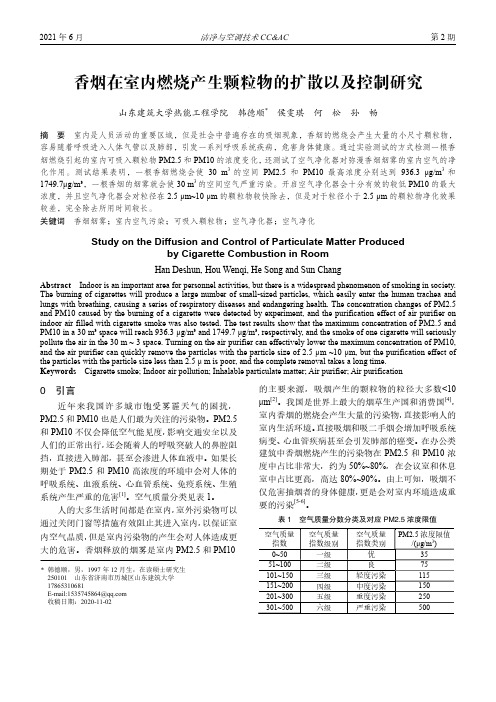
香烟在室内燃烧产生颗粒物的扩散以及控制研究山东建筑大学热能工程学院 韩德顺* 侯雯琪 何 松 孙 畅摘 要 室内是人员活动的重要区域,但是社会中普遍存在的吸烟现象,香烟的燃烧会产生大量的小尺寸颗粒物,容易随着呼吸进入人体气管以及肺部,引发一系列呼吸系统疾病,危害身体健康。
通过实验测试的方式检测一根香烟燃烧引起的室内可吸入颗粒物PM2.5和PM10的浓度变化,还测试了空气净化器对弥漫香烟烟雾的室内空气的净化作用。
测试结果表明,一根香烟燃烧会使30 m 3的空间PM2.5和PM10最高浓度分别达到936.3 μg/m 3和1749.7μg/m³,一根香烟的烟雾就会使30 m 3的空间空气严重污染。
开启空气净化器会十分有效的较低PM10的最大浓度,并且空气净化器会对粒径在2.5 μm~10 μm 的颗粒物较快除去,但是对于粒径小于2.5 μm 的颗粒物净化效果较差,完全除去所用时间较长。
关键词 香烟烟雾;室内空气污染;可吸入颗粒物;空气净化器;空气净化Study on the Diffusion and Control of Particulate Matter Producedby Cigarette Combustion in RoomHan Deshun, Hou Wenqi, He Song and Sun ChangAbstract Indoor is an important area for personnel activities, but there is a widespread phenomenon of smoking in society. The burning of cigarettes will produce a large number of small-sized particles, which easily enter the human trachea and lungs with breathing, causing a series of respiratory diseases and endangering health. The concentration changes of PM2.5 and PM10 caused by the burning of a cigarette were detected by experiment, and the purification effect of air purifier on indoor air filled with cigarette smoke was also tested. The test results show that the maximum concentration of PM2.5 and PM10 in a 30 m³ space will reach 936.3 μg/m³ and 1749.7 μg/m³, respectively, and the smoke of one cigarette will seriously pollute the air in the 30 m ~ 3 space. Turning on the air purifier can effectively lower the maximum concentration of PM10, and the air purifier can quickly remove the particles with the particle size of 2.5 μm ~10 μm, but the purification effect of the particles with the particle size less than 2.5 μ m is poor, and the complete removal takes a long time. Keywords Cigarette smoke; Indoor air pollution; Inhalable particulate matter; Air purifier; Air purification0 引言近年来我国许多城市饱受雾霾天气的困扰,PM2.5和PM10也是人们最为关注的污染物。
文明吸烟环境建设路径研究

现代商贸工业Modern Business Trade Industry2024年第10期基金项目:2022年陕西省烟草公司咸阳市公司科技项目 文明吸烟环境建设全流程规划与数字化管理研究 (XYKJ -2022-06)㊂作者简介:许峰(1973-),男,陕西乾县人,咸阳市烟草公司卷烟营销中心科长,主要从事卷烟营销管理㊁烟叶种植㊁卷烟法律法规等工作;李向(1988-),男,陕西淳化人,咸阳市烟草公司兴平市分公司副经理,主要从事卷烟营销管理工作;刘泽华(1990-),男,内蒙古呼和浩特人,主要从事卷烟营销管理工作㊂文明吸烟环境建设路径研究许㊀峰1㊀李㊀向2㊀刘泽华1(1.咸阳市烟草公司卷烟营销中心,陕西咸阳712099;2.咸阳市烟草公司兴平市分公司,陕西咸阳713100)摘㊀要:随着社会经济的快速发展和人民生活水平的不断提高,公共卫生和环境保护已成为社会关注的焦点㊂文明吸烟环境建设是社会人文环境建设的重要组成部分,对于保护人民群众健康,推动社会文明进步具有重要意义㊂本文基于社会环境建设视域下,系统分析了我国文明吸烟环境建设所面临的现状和存在的问题,并提出了一系列切实可行的建设路径和策略,要加强法规建设㊁完善政策体系㊁提升公众健康意识㊁创新监管机制和优化基础设施等,为深化文明吸烟环境建设提供了理论依据和策略支持,对于推进我国社会人文环境建设,实现社会文明的高质量发展具有重要的参考价值㊂关键词:社会人文环境建设;文明吸烟;环境建设;路径和策略中图分类号:D9㊀㊀㊀㊀㊀文献标识码:A㊀㊀㊀㊀㊀㊀doi:10.19311/ki.1672-3198.2024.10.0590㊀引言随着社会人文环境建设的深入推进和城市化进程的加速,构建文明吸烟环境已成为社会发展的必要需求㊂社会人文环境建设倡导人与自然和谐相处,推动绿色㊁可持续的发展方式,这与传统的吸烟文化存在显著冲突㊂为了改善公共空间的环境质量,保护人民群众的健康,越来越多的国家和地区开始通过建设文明吸烟环境来引导公众文明㊁健康地吸烟㊂然而,文明吸烟环境的建设并非一蹴而就,它涉及文化㊁经济㊁法律㊁健康等多个领域,其管理和引导需要全社会共同参与,形成合力㊂目前,我国文明吸烟环境建设受到监管体系不完善㊁公众对文明吸烟认知的缺乏㊁经济激励和约束机制的不成熟以及基础设施建设的滞后等多方面因素的制约,这些问题制约了文明吸烟环境建设的进一步推进,必须探索行之有效的建设方法与路径㊂因此,本文将基于社会人文环境建设视域下,探讨我国并提出构建文明吸烟环境的具体路径和策略,以期解决我国文明吸烟环境建设存在的问题,为推动我国文明吸烟环境建设提供理论支持和实践指导㊂1㊀当前社会吸烟环境问题1.1㊀吸烟对环境污染的影响烟蒂中的有害化学成分具有较强的渗透性,能够深入土壤和水体,对农作物的生长和水源的纯净度造成严重污染,从而破坏生态系统平衡;空气中悬浮的烟雾不仅影响视觉环境的美观度,还加剧了城市空气中雾霾的密度,对城市空气质量造成负面影响㊂1.2㊀吸烟对人类健康的威胁烟雾中所含的尼古丁㊁焦油和一氧化碳等有毒成分能够诱发一系列呼吸系统疾病,如慢性阻塞性肺病和肺癌,同时还增加心血管疾病㊁卒中和高血压的患病风险㊂各种癌症,包括喉癌㊁口腔癌和胰腺癌等,也与烟雾暴露密切相关㊂孕妇如果长期暴露于烟雾环境中会增加胎儿发育异常的风险,表现为流产㊁早产及低出生体重,并可能引发新生儿的健康问题,严重甚至死亡㊂1.3㊀吸烟文化与社会人文环境建设的矛盾社会人文环境建设倡导人类与自然和谐共生,推崇绿色和环保的生活方式,而吸烟文化往往与之背道而驰㊂一方面,吸烟引发的空气质量恶化和烟蒂随意弃置的现象与社会人文环境建设的目标形成了鲜明对比㊂另一方面,吸烟文化中常见的一些行为和观念,如群体吸烟㊁烟草作为礼物等,不仅传播了不健康的生活观念,还促使了烟草消费的增长,从而对环境和社会造成了负担和压力㊂2㊀文明吸烟环境建设存在的问题2.1㊀室内外吸烟区域的设备不足虽然部分公共空间为顺应文明吸烟环境建设的需求,设立了专门的吸烟室或区域,然而在执行层面仍显现出诸多挑战㊂吸烟区域的标志并不醒目,缺少有效的导向措施,使得吸烟者难以迅速定位到设定的吸烟场所,这显然削弱了文明吸烟环境建设的成效㊂其次,当前许多公共空间在吸烟区的规划上存在模糊之处,未能对边界进行精确划分,一些吸烟区域甚至设置在露天空㊃671㊃2024年第10期现代商贸工业Modern Business Trade Industry地,仅仅是按照文明吸烟的相关规定,划定了一个区域作为吸烟,有的吸烟区甚至设立在室外开放空间,仅仅是依据文明吸烟的相关规定,标出了一个区域用于吸烟,却未配备必要的休息设施和通风装置㊂这种形式主义的建设手法导致吸烟区在实际使用中存在许多不便之处,无法满足吸烟者的基本需求,不利于提高文明吸烟环境的整体效能㊂2.2㊀烟民未形成良好的吸烟习惯吸烟者的个人习惯在一定程度上制约了文明吸烟环境的构建㊂当前,仍有部分吸烟者对公共场所的无烟政策缺乏足够认识,继续在公共场合吸烟㊂同时,由于一些公共场所的吸烟区设置较为隐蔽,一些吸烟者不愿意遵守规定,走到指定的吸烟区域去吸烟,明显削弱了文明吸烟环境建设的成效㊂此外,一些吸烟者在处理烟蒂等吸烟后遗留物品时,选择随手扔掉,而不是妥善处理,这不仅给吸烟区带来了卫生问题,也不符合文明吸烟的要求㊂这些不良习惯的长期存在,将对构建文明吸烟环境产生负面影响,需要通过增强公共宣传和教育来引导吸烟者树立正确的吸烟观念,养成文明的吸烟习惯㊂2.3㊀文明吸烟宣传方法单一文明吸烟宣传主要依赖于线下活动和纸质材料,宣传渠道较为单一,难以吸引到年轻的受众群体㊂此外,宣传内容缺乏创新和生动性,不能深刻触动公众尤其是硬核 烟民的内心,导致宣传效果有限㊂同时,宣传活动的目标群体定位模糊,没有根据不同人群的特点制定差异化策略,单纯的依靠组织线下活动等形式致使宣传质量大打折扣㊂而且,文明吸烟宣传的资源投入较少,影响了宣传活动的规模和深远影响㊂最后,缺乏一个健全的效果评估和反馈机制,使得无法准确把握宣传活动的实际效果,也无法及时调整策略以提升效果㊂2.4㊀缺乏有力的政策支持文明吸烟环境建设的推进受制于政策支持的不足㊂在现有法律框架下,对吸烟行为的制约尚显不足,缺乏有效的管理和惩处机制㊂同时,相关部门在推广文明吸烟环境建设的过程中,政策宣传未能充分到位,使得公众对于文明吸烟的理解并不深刻,主动合作意识和行为也随之欠缺㊂政策执行的漏洞日益明显,对违反规定行为的监管和处罚不足,减弱了政策实施的威慑力㊂此外,现行政策主要集中于对公共场所吸烟的限制,对于提升吸烟区域设施和改善吸烟环境等方面的支持尚显不足㊂这种短视且片面追求速效的做法削弱了文明吸烟环境建设的持续效能和社会影响力,同时也影响了公众对相关政策和措施的信心㊂2.5㊀监管机制尚未全面建立当前,文明吸烟环境建设的监管框架尚待完善,未形成一套全面有效的监控网络㊂在具体的执行层面,吸烟行为的管控需要进一步加强,部分公共场所对禁烟规定的贯彻执行不够严格,使得禁烟成效不显㊂对于违反禁烟条例的处罚力度亦显不足,缺失了必要的震慑效应,致使个别人群对禁烟规定持漠视态度㊂此外,社会监督力量的发挥受限,公众参与监管的渠道尚未畅通,亟需完善相关的举报及反馈机制㊂在监管部门协作方面,也存在一定的不协调现象,信息共享机制有待加强,导致监管工作中出现空白区域,难以构建起统一且高效的工作体系㊂这些问题的存在对构建文明吸烟环境造成了较大阻碍,需要通过提高监管效能㊁优化法规体系㊁增强公众参与度以及提升部门间的协作效率等多途径来增强监管体系的整体功能㊂3㊀文明吸烟环境建设的保障措施3.1㊀建立文明吸烟环境建设体系(1)构建多元化的环境治理模式㊂文明吸烟环境建设也可以作为环境治理的公私合作的探索,最大限度地发挥企业在环境治理中的资金优势和管理模式优势,强化价值创造㊂政府需承担起在资源配置及政策框架设定上的关键角色,引领各类社会资源优先投向文明吸烟环境建设,同时减缓地方财政的负担㊂企业㊁事业单位和社会团体的积极介入应受到鼓励,借助他们在人力资源㊁物资及信息等领域的优势,以提升项目运作的效能和资源利用效率㊂明确的合作框架亦应建立,在契约中具体化各参与方的权利与责任,以确保项目顺畅推进㊂这一多主体参与的治理模式将有助于充分激发社会各界的参与热情,形成以政府为导向,社会广泛参与的良好局面,从而为文明吸烟环境建设提供坚实支撑㊂(2)制定科学的控烟政策㊂对控烟场所进行明确界定,为吸烟者划定明确的专门的吸烟区域,在执法上加大对不文明吸烟行为的惩罚力度或者合理增加处罚措施㊂在具体推进的过程中,首要收集文明吸烟环境建设的需求调查和意见,防止无计划和过度建设的情况发生;其次,学习实践成熟地区的建设经验;再者,在建设过程中,持续进行经验总结和优化提升,寻找一条适合本地情况的文明吸烟环境建设路径,为未来的发展提供坚实基础;最终,我们需要明确责任划分,保持与合作单位的紧密联系,跟踪监控文明吸烟设施的运行状态,并确保其维护㊁管理和保养工作得到妥善完成,以形成既规范又有特色的文明吸烟环境建设操作程序㊂(3)探索烟草制品税制改革试点㊂烟草制品税制改革试点是调控市场㊁促进公共健康的重要举措㊂通过实施差异化税率,可以依据烟草制品的危害程度逐步提高税率,同时加强税收征管和打击走私,确保税制的有效执行㊂增加政策透明度和公开性,通过广泛征求公众意㊃771㊃现代商贸工业Modern Business Trade Industry2024年第10期见,提升政策的科学性和公平性㊂此外,税收收入的合理使用也至关重要,专款专用于公共卫生和烟草控制领域,同时支持烟叶种植区经济转型,帮助烟农稳定收入㊂通过建立科学的评估机制并保持政策的灵活性,我们可以确保税制改革试点取得预期效果,促进公共健康,为政府带来稳定的财政收入㊂3.2㊀加大文明吸烟宣传教育力度推进文明吸烟环境建设,应当加大宣传力度,拓宽宣传渠道,提升公众对文明吸烟环境建设的认知㊂通过多种媒体渠道传播文明吸烟的理念,倡导文明吸烟,引导烟民自觉遵守公共场所的禁烟规定,不在非吸烟区吸烟㊂可以制作一系列短视频,以真实案例或动画形式,揭示二手烟对儿童和非吸烟者的影响,从而唤起公众的关注和共鸣㊂学校和社区作为宣传教育的重要前线,可以定期举办禁烟主题的讲座或活动㊂例如,某中学利用升旗仪式的时间,组织学生进行 拒绝烟草,从我做起 的主题演讲,增强学生对吸烟危害的认识㊂最后,政府和相关部门出台鼓励性政策,引导和支持企业㊁媒体和公众参与到文明吸烟宣传教育中来㊂3.3㊀完善文明吸烟区域设置科学规划和设置吸烟区,避免吸烟区对周围环境的影响㊂在公共场所和工作场所应划定专门的吸烟区域,并确保这些区域远离非吸烟者活动的地方㊂建设专用吸烟区域,减少二手烟暴露,吸烟区域内需要安装足够的通风设施,确保烟雾可以迅速排出,减少空气污染㊂而且吸烟区域应当清晰标识,易于识别,并提供必要的吸烟相关设施,如烟蒂桶等,以方便吸烟者使用,同时鼓励他们将烟蒂正确处理,避免对环境造成污染㊂对于吸烟区域的设置,应当充分考虑吸烟者和非吸烟者的需求,合理规划吸烟区域的位置和大小㊂在一些需要严格控制吸烟的场所,如医院和学校,应当设立更多的非吸烟区域,甚至可以考虑完全禁烟㊂3.4㊀优化监管机制为了强化监管效果,构建一套完善的监管体系至关重要㊂通过制定严格的控烟条例,明确了公共场所禁烟的规范,并对吸烟区进行了严格限制,确保吸烟行为不会对公众健康造成威胁㊂其次,利用视频监控和大数据分析等现代技术,对违规吸烟行为进行实时监控,提高了处罚的及时性和准确性㊂此外,通过鼓励市民参与举报,并设立专门的举报渠道,让监管变得更加人性化,形成了政府㊁社会和公众共同参与的监管网络㊂通过这些措施,不仅提升了监管效能,也增强了公众对文明吸烟的认识,为打造健康城市奠定了坚实基础㊂3.5㊀完善法规体系完善法规体系是推进文明吸烟环境建设的关键一环㊂这需要从立法层面明确禁烟区域的范围㊁规定吸烟区的设置标准,并对违反规定的个人和单位施以相应的处罚㊂以北京市为例,其‘北京市控制吸烟条例“就对吸烟区域进行了严格限制,并对违法行为设定了明确的法律责任㊂为了适应新时代的需求,相关法规还需不断更新完善,增加对电子烟等新型吸烟产品的管理,确保法规体系能够全面覆盖㊁有效应对各种吸烟行为㊂此外,还应强化法规的执行力度,提高执法人员的专业水平,可以考虑引入现代技术手段,如视频监控㊁大数据分析等,提高监管效率和准确性,真正发挥其对文明吸烟环境建设的引导和规范作用㊂4㊀结论文明吸烟环境建设是一项系统工程,涉及到法规制定㊁宣传教育㊁环境优化㊁监管机制以及后期管护等多个方面㊂为了确保其效果,需要政府㊁企业㊁社会组织和公众共同参与,形成协同效应㊂通过完善相关法规体系,加强宣传教育力度,优化文明吸烟区域设置,并构建有效的监管机制,不断提升文明吸烟环境建设的质量和效率,为建设更加健康㊁文明的社会环境贡献力量㊂同时,注重后期管护,确保吸烟区域及其设施的长期有效运作,也是实现文明吸烟环境建设目标不可或缺的一环㊂通过以上措施的综合施行,我们有信心逐步引导公众形成正确的吸烟观念,营造健康㊁文明㊁和谐的吸烟环境㊂参考文献[1]杨坤.深化文明吸烟环境建设方法与路径研究[J].国际公关,2023,(08):40-42.[2]杨颖.文明吸烟环境建设的路径探析[C].中国烟草学会2018年学术年会.中国烟草学会,2018.[3]马伟国.浅议文明吸烟环境建设面临的问题及对策[J].东方烟草报,2018,(11):03.[4]梁甜甜.多元环境治理体系中政府和企业的主体定位及其功能[J].当代法学,2018,(5):89-98.[5]滕洁.烟草商业企业文明吸烟环境建设研究与探索[J].天津社会保险,2019,(01):32.[6]潘妍,石锐,田梦萍.科技引领文明吸烟软环境体系建设:意义,现状与路径[J].科技智囊,2021,(9):8.㊃871㊃。
烟草烟雾对室内空气污染的影响
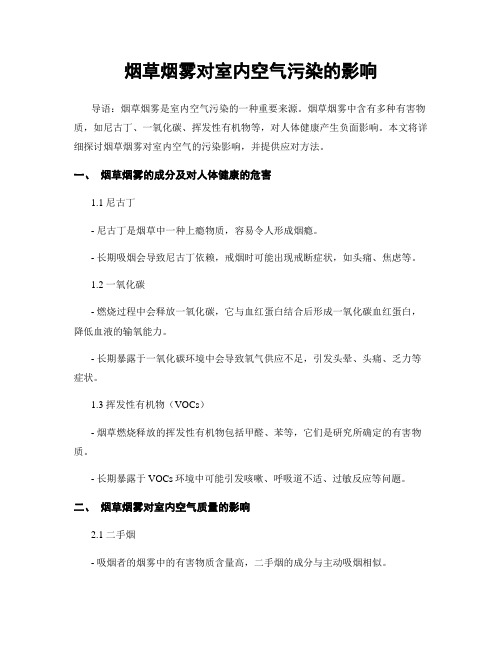
烟草烟雾对室内空气污染的影响导语:烟草烟雾是室内空气污染的一种重要来源。
烟草烟雾中含有多种有害物质,如尼古丁、一氧化碳、挥发性有机物等,对人体健康产生负面影响。
本文将详细探讨烟草烟雾对室内空气的污染影响,并提供应对方法。
一、烟草烟雾的成分及对人体健康的危害1.1 尼古丁- 尼古丁是烟草中一种上瘾物质,容易令人形成烟瘾。
- 长期吸烟会导致尼古丁依赖,戒烟时可能出现戒断症状,如头痛、焦虑等。
1.2 一氧化碳- 燃烧过程中会释放一氧化碳,它与血红蛋白结合后形成一氧化碳血红蛋白,降低血液的输氧能力。
- 长期暴露于一氧化碳环境中会导致氧气供应不足,引发头晕、头痛、乏力等症状。
1.3 挥发性有机物(VOCs)- 烟草燃烧释放的挥发性有机物包括甲醛、苯等,它们是研究所确定的有害物质。
- 长期暴露于VOCs环境中可能引发咳嗽、呼吸道不适、过敏反应等问题。
二、烟草烟雾对室内空气质量的影响2.1 二手烟- 吸烟者的烟雾中的有害物质含量高,二手烟的成分与主动吸烟相似。
- 二手烟会悬浮在室内空气中,对附近的非吸烟者构成健康威胁。
2.2 室内污染物积累- 吸烟者长时间在室内吸烟,烟雾中的有害物质会在室内空气中积累。
- 室内空气流通不畅时,这些有害物质难以排除,导致室内空气质量下降。
2.3 过滤困难- 烟草烟雾中的微小颗粒物质较难被普通空气净化器过滤掉。
- 这些颗粒物质会悬浮在空气中,进一步增加室内空气污染。
三、应对烟草烟雾污染的方法3.1 室内禁烟- 制定禁烟规定,限制吸烟范围,如在公共场所、办公室等禁止吸烟,保障非吸烟者的权益。
- 对于家庭内部,也可以设立禁烟区域,提供烟草烟雾与非吸烟者隔离的空间。
3.2 多通风- 长时间开启窗户,增加空气流通,有助于将有害物质排除出室内。
- 使用便携式空气净化器进行室内空气净化,排除悬浮颗粒物质和有害气体。
3.3 清洁室内环境- 定期清洁房间,包括地板、窗帘、家具等,减少烟草烟雾残留的机会。
吸烟对室内空气的污染
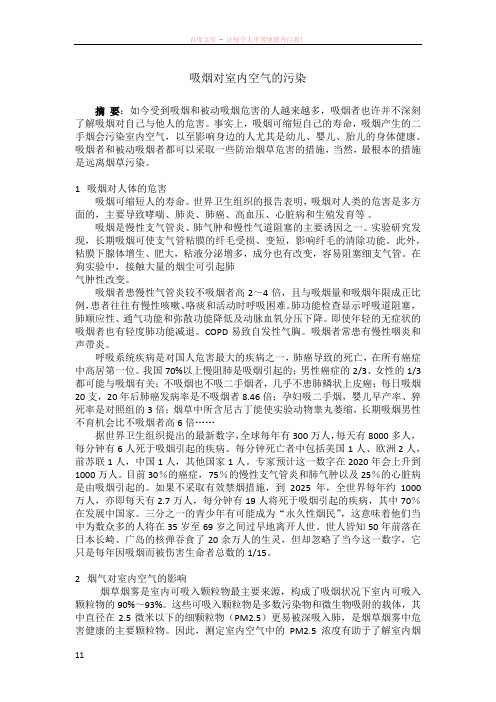
吸烟对室内空气的污染摘要:如今受到吸烟和被动吸烟危害的人越来越多,吸烟者也许并不深刻了解吸烟对自己与他人的危害。
事实上,吸烟可缩短自己的寿命,吸烟产生的二手烟会污染室内空气,以至影响身边的人尤其是幼儿、婴儿、胎儿的身体健康。
吸烟者和被动吸烟者都可以采取一些防治烟草危害的措施,当然,最根本的措施是远离烟草污染。
1 吸烟对人体的危害吸烟可缩短人的寿命。
世界卫生组织的报告表明,吸烟对人类的危害是多方面的,主要导致哮喘、肺炎、肺癌、高血压、心脏病和生殖发育等。
吸烟是慢性支气管炎、肺气肿和慢性气道阻塞的主要诱因之一。
实验研究发现,长期吸烟可使支气管粘膜的纤毛受损、变短,影响纤毛的清除功能。
此外,粘膜下腺体增生、肥大,粘液分泌增多,成分也有改变,容易阻塞细支气管。
在狗实验中,接触大量的烟尘可引起肺气肿性改变。
吸烟者患慢性气管炎较不吸烟者高2~4倍,且与吸烟量和吸烟年限成正比例,患者往往有慢性咳嗽、咯痰和活动时呼吸困难。
肺功能检查显示呼吸道阻塞,肺顺应性、通气功能和弥散功能降低及动脉血氧分压下降。
即使年轻的无症状的吸烟者也有轻度肺功能减退。
COPD易致自发性气胸。
吸烟者常患有慢性咽炎和声带炎。
呼吸系统疾病是对国人危害最大的疾病之一,肺癌导致的死亡,在所有癌症中高居第一位。
我国70%以上慢阻肺是吸烟引起的;男性癌症的2/3、女性的1/3都可能与吸烟有关;不吸烟也不吸二手烟者,几乎不患肺鳞状上皮癌;每日吸烟20支,20年后肺癌发病率是不吸烟者8.46倍;孕妇吸二手烟,婴儿早产率、猝死率是对照组的3倍;烟草中所含尼古丁能使实验动物睾丸萎缩,长期吸烟男性不育机会比不吸烟者高6倍……据世界卫生组织提出的最新数字,全球每年有300万人,每天有8000多人,每分钟有6人死于吸烟引起的疾病。
每分钟死亡者中包括美国1人、欧洲2人,前苏联1人,中国1人,其他国家1人。
专家预计这一数字在2020年会上升到1000万人。
目前 30%的癌症, 75%的慢性支气管炎和肺气肿以及 25%的心脏病是由吸烟引起的。
吸烟对室内空气质量的影响

0.5
0
19
0
6.8
11
50cm
5min
0
0
6
0
5.5
11
10min
0
0
5
0
5
11
温度:28℃ 湿度:60%
在门窗关闭条件下,进行3人各吸一支半x香烟,时间约为3min,分别测量距离吸烟者10cm和 50cm处在1、3、5、10min时NO、CO、硫化氢、总挥发性有机物(VOC),同时测定室内温湿度。并 且在本次结束后打开寝室门窗和风扇,使各项参数恢复实验前水平。
结语
通过这次实验, 我们认识到并亲身 感受到吸烟所带来 的巨大危害,这种 危害不仅仅是带给 吸烟者自己,还有 身边广大的二手烟 受害者,其中就包 括我们的亲人、朋 友。所以今后我们 自己会戒烟并且劝 阻身边的同学朋友 趁早戒烟。
THANK YOU
距离 10cm
50cm
时间 1min 3min 5min 10min 1min 3min 5min 10min
一人抽烟时空气质量参数
NO(mg/m3)
LEL
CO(mg/m3)
硫化氢(mg/m3)
0
0
5
0
0.5
0
13
0
0
0
5
0
0
0
3
0
0
0
4
0
0.5
0
10
0
0
0
5
0
0
0
4
0
温度:28℃ 湿度:60%
VOC(mg/m3) 6.2 7.3 5.6 5.9 6.1 6.8 5.3 5
吸烟对室内空气质量的影响 ———建筑环境实验
抽烟的危害研究报告

抽烟的危害研究报告据世卫组织统计,目前全球每年约有500万人因吸烟而死亡,烟草已成为继高血压之后的第二号“杀手”。
世卫组织估计,如果不加以控制,到2020年每年吸烟致死的人数有可能增加一倍。
在全球13亿烟民中,有亿人会因为吸烟而过早死亡。
而每一包香烟上都写着吸烟有害健康的字样,即使这样,为什么人们还要吸烟呢?特别是中学生吸烟的现象更是屡见不凡,why?对此我对吸烟的危害做了科学的调查。
一、研究的意义我这次主要是针对于吸烟的危害进行了一次研究性学习报告,这次活动的目的是向大家介绍香烟的危害以及该如何面对现在的这个现状。
还有就是通过这个研究性课题报告能够让人们知道它给我们带来的危害,让人们不在接触这个东西。
二、什么是香烟。
香烟,是烟草制品的一种。
制法是把烟草烤干后切丝,然后以纸卷成长约120mm,直径10mm的圆桶形条状。
吸食时把其中一端点燃,然后在另一端用口吸咄产生的烟雾。
香烟最初在土耳其一带流行,当地的人喜欢把烟丝以报纸卷起来吸食。
在克里米亚战争中,英国士兵从时的鄂图曼帝国士兵中学会了吸食方法,之后传播到不同地方。
大部份的香烟成份之中并不单只有烟草。
生产商通常在香烟内加入大量不同的添加剂,目的是控制烟丝的成份和质量,防腐,以及改变燃点时烟雾对吸食者所能产生的感觉。
有些香烟加入了丁香,目的是令吸烟者的口及肺部出现少量痳痹,从而产生轻微的快感。
部分低价香烟会直接加入丁香的提取精华。
有些香烟的烟丝经过很多的特别处理。
在烟叶最初的处理过程中,会产生大量尘状的碎烟草。
这些烟草尘会被收集然后再造成为香烟内的成份。
香烟到最后都会成为灰烬大量香烟头除了添加剂外,烟草,尤其是粗糙的加工,对人体伤害十分明显。
香烟里的化学物质虽然主要是干烟草但是是经过化学处理又加了很多添加成份。
燃点香烟的烟雾含约4000种化学物质,很多是有毒物质,引致异变物质及致癌物质。
不同牌子不同产地不同盒不因一批香烟含量各异。
三、调查问题1、你什么时候开始吸烟?我设臵了四个选项,分别是小学、初中、高中和不吸烟,其中小学开始吸烟的占了20%,初中开始吸烟的占了35%,高中和初中一样是35%,而不吸烟的人只有10%,也就是说我们调查的50个人中,只有5个人不吸烟,更有10个人在小学就开始吸烟,这个数据让我们不得不正视青少年吸烟的问题。
吸烟与环境污染问题
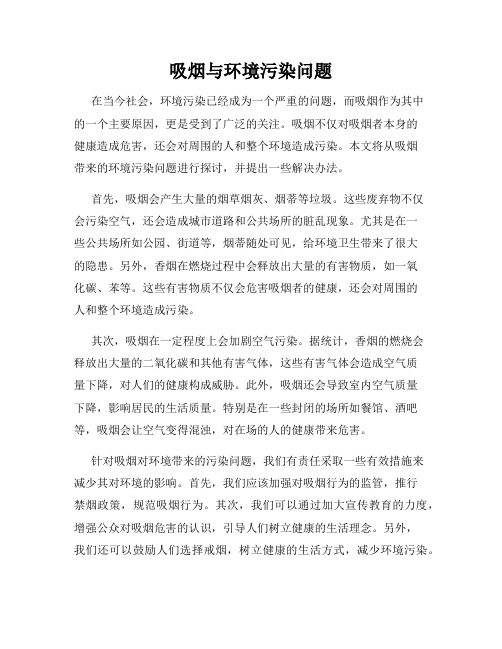
吸烟与环境污染问题在当今社会,环境污染已经成为一个严重的问题,而吸烟作为其中的一个主要原因,更是受到了广泛的关注。
吸烟不仅对吸烟者本身的健康造成危害,还会对周围的人和整个环境造成污染。
本文将从吸烟带来的环境污染问题进行探讨,并提出一些解决办法。
首先,吸烟会产生大量的烟草烟灰、烟蒂等垃圾。
这些废弃物不仅会污染空气,还会造成城市道路和公共场所的脏乱现象。
尤其是在一些公共场所如公园、街道等,烟蒂随处可见,给环境卫生带来了很大的隐患。
另外,香烟在燃烧过程中会释放出大量的有害物质,如一氧化碳、苯等。
这些有害物质不仅会危害吸烟者的健康,还会对周围的人和整个环境造成污染。
其次,吸烟在一定程度上会加剧空气污染。
据统计,香烟的燃烧会释放出大量的二氧化碳和其他有害气体,这些有害气体会造成空气质量下降,对人们的健康构成威胁。
此外,吸烟还会导致室内空气质量下降,影响居民的生活质量。
特别是在一些封闭的场所如餐馆、酒吧等,吸烟会让空气变得混浊,对在场的人的健康带来危害。
针对吸烟对环境带来的污染问题,我们有责任采取一些有效措施来减少其对环境的影响。
首先,我们应该加强对吸烟行为的监管,推行禁烟政策,规范吸烟行为。
其次,我们可以通过加大宣传教育的力度,增强公众对吸烟危害的认识,引导人们树立健康的生活理念。
另外,我们还可以鼓励人们选择戒烟,树立健康的生活方式,减少环境污染。
总之,吸烟与环境污染问题不容忽视,我们每个人都有责任为减少环境污染做出努力。
通过加强监管、加大宣传教育以及鼓励戒烟等方式,我们可以减少吸烟对环境的污染,营造一个更加清洁、健康的生活环境。
希望大家都能珍爱环境,共同呵护我们的地球家园。
【字数:504】。
室内空气污染的主要来源

室内空气污染的主要来源一、人体本身这是一个极易为人们忽视的事实——人体本身就是室内空气污染的重要来源。
这是因为,人活着,就在不断地向外界呼出二氧化碳、水蒸气,释放出多种细菌和多种气味。
据研究,人肺可排出25种有毒物质,人呼出的气体中竟含有16种挥发性毒物。
这一点,人们都会有切身体验,当我们走进拥挤、密闭的房间,或乘上几站几乎无立足之地的公共汽车时,常会感到头晕、目眩,时间久了,甚至会感到胸闷、恶心、出虚汗。
这种不适感,国外医学家称之为“闷屋综合征”。
其实质就是众多的人呼出的有害物质污染了空气。
人们若长期吸入这种污染的空气,便会出现那些症状,导致“闷屋综合征”的产生。
二、采暖、烹饪、吸烟及其它家务劳动这也是室内空气污染的重要来源。
在采暖和烹饪的过程中,如果使用煤、煤气或其它燃料,常会产生CO、NO、SO2、CO2及未完全氧化的烃类和微粒。
一般说来,煤的污染比液化气和煤气为重,尤以氧气供给不足时更为严重。
在室内吸烟,会严重造成室内空气污染,吸烟产生的化学物质竟有1200多种,其中重要的有害物质就有30余种,不容轻视。
三、家务劳作使用的化学溶剂业余爱好者使用的许多种化学溶剂,如染发等药品,以及进行室内消毒、杀虫、灭鼠等化学剂,都会给室内空气造成程度不同的污染。
四、建筑材料及室内设备建筑材料的现代化,使一些含有甲醛、氡和石棉的房屋建筑材料日益增多。
五、家电微波、电磁波辐射。
六、如果居室位于城市工业区内,工业废气及交通工具排出的废气,也可加重室内空气的污染程度,并大大超过室外空气的污染程度,尤其是在冬季门窗关闭情况下更为明显。
室内空气污染的严重后果由于室内空气污染常常是在人们不知不觉之中引起疾病或加剧病情的,因而使人们对它失去警觉而掉以轻心。
对于这个隐藏在我们身边的健康之敌,必须认清它的本来面目。
- 1、下载文档前请自行甄别文档内容的完整性,平台不提供额外的编辑、内容补充、找答案等附加服务。
- 2、"仅部分预览"的文档,不可在线预览部分如存在完整性等问题,可反馈申请退款(可完整预览的文档不适用该条件!)。
- 3、如文档侵犯您的权益,请联系客服反馈,我们会尽快为您处理(人工客服工作时间:9:00-18:30)。
吸烟对室内空气污染的研究作者:陈宇炼, 唐加林, 张敏会, 周闰作者单位:南京医科大学公共卫生学院,江苏,南京,210029刊名:环境与健康杂志英文刊名:JOURNAL OF ENVIRONMENT AND HEALTH年,卷(期):2008,25(12)引用次数:0次1.邓大跃.郑霜.陈双基室内不同燃烧模式香烟污染的研究[期刊论文]-环境科学与技术 2006(12)2.韩光红.陈宁庆吸烟对健康的危害与控烟运动[期刊论文]-解放军预防医学杂志 19973.Donsfeng G.Xigui W.Kristi R Cigarette smoking and exposure to envimnmental tobacco smoke in China:the international collaborative study of cardiovaacular disease in A8ia 20044.应桂英.刘熹.甘德坤被动吸烟对非吸烟妇女健康影响的研究现状[期刊论文]-现代预防医学 2006(1 1)5.高之清香烟烟雾中的毒物及其危害[期刊论文]-化学世界 2005(04)6.闫克玉.王建民.姚二民卷烟烟气气相中的有害物质及其减少措施[期刊论文]-郑州轻工业学院学报(自然科学版) 2005(04)7.赵冰.李春松.闫克玉卷烟烟气粒相中的有害物质的形成、危害及减少措施[期刊论文]-郑州轻工业学院学报(自然科学版) 2006(02)8.谢田.李义.李敏烟民居室吸烟致CO的污染及防治措施研究 1999(01)9.阙惠芳甲醛与人体健康 1993(01)10.张文华.粱宝英吸烟对室内空气的污染 1991(02)1.外文期刊Metayer Catherine.Ward Mary H.Nishioka Marcia G.Gunier Robert.Colt Joanne S.ReynoldsPeggy.Selvin Steve.Buffler Patricia.Rappaport Stephen M Is house-dust nicotine a good surrogate forhousehold smoking?The literature is inconsistent regarding associations between parental smoking and childhood leukemia, possibly because previous studies used self-reported smoking habits as surrogates for children's true exposures to cigarette smoke. Here, the authors investigated the use of nicotine concentrations in house dust as measures of children's exposure to cigarette smoke in 469 households from the Northern California Childhood Leukemia Study (1999-2007). House dust was collected by using high-volume surface samplers and household vacuum cleaners and was analyzed for nicotine via gas chromatography-mass spectrometry. Using multivariable linear regression, the authors evaluated the effects of self-reported parental smoking, parental demographics, house characteristics, and other covariates on house-dust nicotine concentrations. They observed that nicotine concentrations in house dust were associated with self-reported smoking for periods of months and years before dust collection. Furthermore, the authors found that the relation between nicotine dust levels and self-reported smoking varied by parental age and socioeconomic status. These findings suggest that house-dust nicotine concentrations reflect long-term exposures to cigarette smoke in the home and that they may be less biased surrogates for children's exposures to cigarette smoke than self-reported smoking habits.2.外文期刊Dinno A.Glantz S Tobacco control policies are egalitarian: a vulnerabilities perspectiveon clean indoor air laws, cigarette prices, and tobacco use disparities.This study models independent associations of state or local strong clean indoor air laws and cigarette prices with current smoker status and consumption in a multilevel framework, including interactions with educational attainment, household income and race/ethnicity and the relationships of these policies to vulnerabilities in smoking behavior. Cross sectional survey data are employed from the February 2002 panel of the Tobacco Use Supplement of the Current Population Survey (54,024 individuals representing the US population aged 15-80). Non-linear relationships between both outcome variables and the predictors were modeled. Independent associations of strong clean indoor air laws were found for current smoker status (OR 0.66), and consumption among current smokers (-2.36 cigarettes/day). Cigarette price was found to have independent associations with both outcomes, an effect that saturated at higher prices. The odds ratio for smoking for the highest versus lowest price over the range where there was a price effect was 0.83. Average consumption declined (-1.16 cigarettes/day) over the range of effect of price on consumption. Neither policy varied in its effect by educational attainment, or household income. The association of cigarette price with reduced smoking participation and consumption was not found to vary with race/ethnicity. Population vulnerability in consumption appears to be structured by non-white race categories, but not at the state and county levels at which the policies we studied were enacted. Clean indoor air laws andprice increases appear to benefit all socio-economic and race/ethnic groups in our study equally in terms of reducing smokingparticipation and consumption.3.期刊论文赵厚银.邵龙义.姚强.ZHAO Hou-yin.SHAO Long-yi.YAO Qiang北京市冬季部分住宅室内PM10中化学元素研究-环境与健康杂志2006,23(1)目的研究北京市部分住宅室内空气中PM10的化学元素成分,并探讨各元素的来源.方法2002年12月-2003年3月应用撞击式采样器在北京市4户吸烟和非吸烟室内采集PM10样品,使用质子诱导X射线荧光法(PIXE)和富集因子法分析Al、Si、P、S、Cl等19种元素的平均质量浓度及富集特征.结果吸烟室内空气中PM10的19种元素的总浓度明显高于非吸烟室内,特别是K、S的浓度是非吸烟室内的2~4倍.室内空气中PM10的元素质量浓度主要由Al、Si、S、K、Ca、Fe等6种元素贡献,其中,吸烟室内K和S占分析元素总量的71.50%,而在非吸烟室内Al、Si和Ca占57.06%.结论Al、Si、Ca、Ti、Fe等来自自然源,而S、Zn、Pb、Cr、Cu、As、Cl、P等来自人为源,如吸烟、燃煤、燃油等.4.期刊论文黄露.杨功焕.郭新彪.马少俊公共场所和工作场所环境空气中烟草烟雾污染状况的研究-环境与健康杂志2007,24(7)目的 了解北京市东城区公共场所和工作场所环境中烟草烟雾的暴露情况及其影响因素.方法 于2004年1-2月选取北京市东城区14家公共场所和工作场所,采用被动式尼古丁采样器对场所环境空气中的尼古丁水平进行监测.应用多元线性回归方程对影响尼古丁浓度的因素进行分析.结果 14家公共场所和工作场所中的所有采样点均检测到了尼古丁,其浓度中位数为3.01 μg/m3,浓度范围为0.03~28.72 μg/m3.完全禁烟场所检测到的尼古丁浓度中位数最低,而在无禁烟规定的场所中检测到的尼古丁浓度中位数最高.影响室内空气中尼古丁浓度的因素较多,包括禁烟规定、吸烟人数和房屋面积等,其中吸烟人数是最重要的因素.结论 目前,公共场所和工作场所的环境烟草烟雾暴露已成为重要的公共卫生和职业健康问题,吸烟人数对空气中尼古丁浓度的影响最大.5.期刊论文罗鹏.张爱华.洪峰.梁冰.肖婷婷.杨光红.黄晓欣.董学新.张碧霞.杨大平.徐晓筑.LUO Peng.ZHANG Ai-hua.HONG Feng.LIANG Bing.XIAO Ting-ting.YANG Guang-hong.HUANG Xiao-xin.DONG Xue-xin.ZHANG Bi-xia. YANG Da-ping.XU Xiao-zhu贵州省燃煤污染型砷中毒病区9年前后环境危险因素比较分析-中国地方病学杂志2009,28(1)目的 对比分析贵州省兴仁县燃煤污染型砷中毒病区9年前后(1998、2006年)环境危险因素的变化,为了解该病的发生、发展原因和进一步采取针对性十预控制措施提供依据.方法 采用典型抽样方法对1998年确诊的181例燃煤污染型砷中毒患者进行追踪调查,调查的项目包括年龄、性别、家庭经济状况、燃用和停用高砷煤年限、室内通风情况、食物十燥方式、吸烟等;同时选择病区12 km以外非砷污染村65例居民作为对照组.采用二乙基二硫代甲酸银法(Ag-DDC)测定煤、土壤、空气、水、大米、玉米和辣椒中含砷量:单因素和多因素非条件Logistic回归模型分析燃煤污染型砷中毒人群的暴露凶素和环境危险冈索的关系,比较9年前后的差异.结果 病区室内、室外空气和燃煤、辣椒、玉米含砷量均值由1998年的0.0880、0.0220 mg/m3和397.20、45.07、2.64 mg/kg分别下降到2006年的0.0790、0.0070 mg/m3和93.01、3.46、1.50 mg/kg.9年前后的多因素非条件Logistic回归分析,在发生燃煤污染型砷中毒的相关因素中,危险因素为燃用高砷煤年限、年龄、氟中毒和吸烟(x2值分别为50.159、12.195、37.690、6.358,P<0.01或<0.05),影响因素为家庭经济状况(x2=4.614,P<0.05);居室通风情况由1998年的危险因素转变为2006年的影响因素(x2=38.093.P<0.01);煤火烘烤粮食和文化程度,在2006年不再是危险冈素和影响因素,但粮食保存方式和性别成为影响因素(x2值分别为17.463,11.004,P<0.01).结论 贵州省兴仁县燃煤污染型砷中毒病区9年后环境砷污染状况明显改善,病区低剂量砷污染的持续存在是该型砷中毒未得以明显控制的主要原因;燃用高砷煤年限、年龄、吸烟、氟中毒、家庭经济状况和居室通风情况与该病的发生发展密切相关;切实禁绝燃用高砷煤、加强和巩固改炉改灶和发展病区经济是进一步控制燃煤污染型砷中毒的有效措施.6.期刊论文王美霞.李念平.李灿.WANG Mei-xia.LI Nian-ping.LI Can地板送风室内可吸人颗粒物粒径及浓度分布特征-环境与健康杂志2008,25(2)目的 研究地板送风情况下室内可吸入颗粒物粒径分布特点,并分析人员活动和吸烟对其影响.方法 于2007年6-7月,测定了地板送风系统室内空气中各粒径可吸入颗粒物的频数(假设颗粒为球体且密度为1 g/cm3),计算出颗粒物的表面积和质量浓度并用公式表示出粒径与频数、表面积和质量浓度的关系.结果 颗粒物粒径(d)的对数与累积频数(Cm)的对数呈线性关系(lnCm=15.41-3.28lnd,r=-0.986),累积总表面积(Cm)的对数与粒径呈线性关系(lnCm=0.21-0.51 d,r=-0.980),累积总质量浓度(Gm)的对数与粒径呈线性关系(lnCm=4.16-0.30d,r=-0.987).人员活动使室内空气中粒径大于等于lμm的颗粒物浓度增加,总质量浓度增加为无人员活动时的约2倍.而吸烟使室内空气中粒径小于等于1μm的颗粒物浓度增加.结论 颗粒物粒径与累积频数、累积总表面积、累积总质量浓度有关.7.期刊论文王海龙.王春芳.田树华.张彰.姜远虹.庞敏被动吸烟对大鼠肺组织Clara细胞及CC16的影响-环境与健康杂志2007,24(10)目的 研究被动吸烟不同时间大鼠肺组织Clara细胞及其分泌蛋白CC16的变化,以探讨被动吸烟与肺部慢性炎症性疾病发生的关系.方法 将Wistar雄性大鼠随机分为被动吸烟1、2、3月组和正常对照组,每组10只.进行HE染色,观察实验组大鼠肺组织光镜表现,以透射电镜观察其Clara细胞的超微结构.以RT-PCR法检测各组大鼠肺组织CC16mRNA的表达水平,以免疫组织化学法检测肺组织Clara细胞数量,以酶联免疫吸附法检测支气管肺泡灌洗液(BALF)中CC16含量.结果 被动吸烟3月组大鼠终末细支管上皮Clara细胞超微结构有显著改变;HE染色见肺泡壁变薄,相互融合成肺大泡.随着被动吸烟时间的延长,大鼠肺组织CC16 mRNA的表达、Clara细胞的数量及BALF中CC16的含量逐渐降低.被动吸烟2月和3月组大鼠肺组织CC16 mRNA的表达、Clara细胞的数量及BALF中CC16的含量与正常对照组比较,差异有统计学意义(P均<0.01).被动吸烟1月组大鼠肺组织CC16 mRNA的表达、Clara细胞的数量及BALF中CC16的含量与对照组比较,差异无统计学意义(P>0.05).结论 在一定吸烟量条件下,随暴露时间延长,Clara细胞数量及CC16的合成及分泌量减少,这可能与肺部慢性炎症性疾病的发生发展有一定的关系.8.期刊论文丁剑.彭瑞玲.岳伟.潘小川北京某城区居室内空气污染现状及其影响因素-环境与健康杂志2004,21(6)目的调查北京市某城区居室内空气污染现状,初步探讨影响室内空气中甲醛和氮氧化物(NOx)浓度的室内因素.方法在北京市西城区随机抽取463位居民进行室内环境状况问卷调查,从被调查者中随机抽取9l户家庭,入户监测其室内空气中甲醛和NOx浓度.采用多元线性模型进行回归分析,筛选出与室内空气中甲醛、NOx浓度密切相关的室内因素.结果室内空气中甲醛日平均浓度为0.049 mg/m3,超标率为13%,装修过的家庭卧室空气中甲醛浓度(0.058mg/m3)明显高于未装修家庭(0.034 mg/m3),差异具有高度显著性(P<0.001);卧室和厨房空气中NOx日平均浓度分别为0.053和0.090 mg/m3,超标率分别为9%和48%,其浓度差异具有高度显著性(P<0.001);装修与否、每月天然气用量、排烟渠道通向入选卧室空气中甲醛浓度回归方程;居室净高、吸烟与否入选卧室空气中NOx浓度回归方程;使用面积、居室净高、采样时间内开火做饭次数入选厨房空气中NOx浓度回归方程.结论该城区居民室内空气中甲醛和NOx污染较严重,家庭装修与卧室空气中甲醛浓度关系最密切,天然气燃烧是厨房空气中NOx和卧室空气中甲醛的重要来源,吸烟是卧室空气中NOx的重要来源之一.9.期刊论文王振全.李盛.魏学玲.欧阳平.严俊.王立辉兰州市住宅空气污染对儿童呼吸系统健康的影响-环境与健康杂志2008,25(10)目的 了解兰州市住宅空气污染对儿童呼吸系统健康的影响.方法 于2006年11月-2007年2月(采暖期)和2007年5-9月(非采暖期),对兰州市城关区、七里河区(文化区)、西固区(工业区)120套住宅室内空气甲醛、苯、SO2、NO2、CO和可吸入颗粒(PM10)浓度进行检测.采用儿童健康状况调查表对被检测地行Logistic回归分析.结果 兰州市采暖期居室空气中SO2、CO、NO2、PM10浓度高于非采暖期,差异有统计学意义(P<0.05).PM10污染最为严重.室外空气污染是儿童呼吸道病症发生的危险因素;引起儿童呼吸道病症的室内空气污染危险因素主要有家人吸烟、装修程度、燃料类型、开窗通风等;母亲文化水平以及性别、年龄对儿童呼吸系统病症的发生也有一定的作用.结论 儿童呼吸系统疾病的发生是室内空气污染源及其散发强度、住宅外空气污染程度、人群自身因素和行为综合作用的结果.10.期刊论文赖森潮.苏广宁.邹世春.曹军骥广州市部分居室空气中PM2.5污染特征-环境与健康杂志2006,23(1) 目的了解广州市居民室内空气中PM2.5的污染特征并探讨其污染来源.方法于2003年6-7月期间,使用低流量采样器于广州市9个有代表性居民住宅采集室内PM25样品,测定其浓度及有机碳(OC)和元素碳(EC)的含量.结果室内采样点PM25平均浓度为(47.4±17.7)μg/m3,高于其他国家或地区已有的监测结果.PM25中OC和EC的平均浓度分别为(9.2±1.4)、(3.72±0.48)μg/m3;OC和EC分别占PM25的26.4%±5.6%和9.3%±4.8%.其中,OC主要来源于室内的污染源,而EC则可能与室外污染源的关系更为密切.结论室内污染源(烹饪、吸烟等)、室外污染源(机动车排放)以及房屋条件(通风条件、装修时间)等对室内的PM25浓度水平的影响较大.本文链接:/Periodical_hjyjkzz200812015.aspx下载时间:2010年5月31日。
